前回 Pt.7 では、圧電素子を使ったクリスタルカートリッジの普及とジュークボックスの関係、また Brush Development が提唱していたクリスタルカッターを使った定振幅記録再生(イコライズレス)の試みなど、あれこれについて調べました。
On the previous part 7, I studied on the advent of piezo-electric pickups and the relationship with jukeboxes; an attempt to popularize constant-amplitude recording/reproducing without utilizing equalizers, etc.
今回はその続きで、ついに、史上初めて標準規格として策定された、1942年 NAB 規格の経緯 について、長文になりますがみていきましょう。
This time, I am going to continue learning the history of 1942 NAB Standards, the first standardization ever in industry. It will become a very long article, but anywhere here we go.
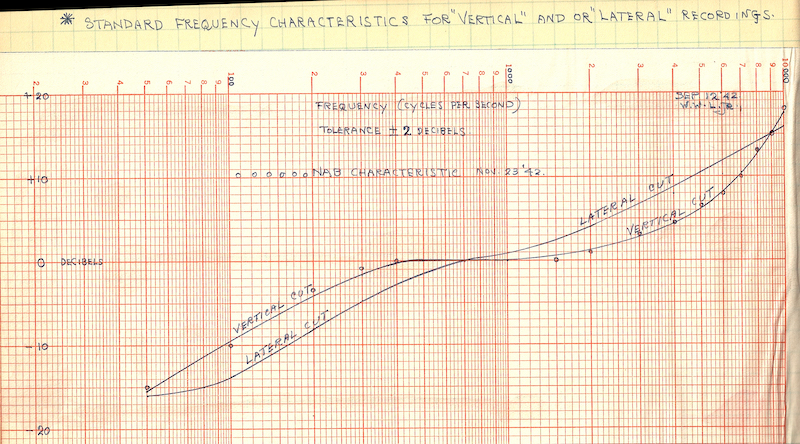
Western Electric Vertical/Lateral Recording Characteristics (1942 NAB), drawn on Nov. 23, 1942
Western Electric 社の縦振動/横振動用録音カーブ (1942 NAB vertical/lateral) をプロットした貴重なグラフ (Nicholas Bergh さん提供)
photo courtesy of Nicholas Bergh.
- 「Pt.0 (はじめに)」
- 「Pt.1 (定速度と定振幅、電気録音黎明期)」
- 「Pt.2 (世界初の電気録音、Brunswick Light-ray、ラジオ業界の脅威)」
- 「Pt.3 (Blumlein システム、当時のRCAやColumbia、民生用における高域プリファレンスの萌芽)」
- 「Pt.4 (Vitaphone、Program Transcription、Electrical Transcription、Bell Labs / Western Electric 縦振動トランスクリプション盤)」
- 「Pt.5 (ベル研とストコフスキーのエピソード、横振動トランスクリプション、Orthacousticカーブ)」
- 「Pt.6 (アセテート録音機のカッターヘッド特性、高調波歪の論文、超軽量ピックアップ)」
- 「Pt.7 (圧電ピックアップとジュークボックス、定速度記録再生の試み)」
の続きです。
This article is a sequel to “Things I learned on Phono EQ curves, Pt.0”, “Pt.1”, “Pt.2”, “Pt.3”, “Pt.4”, “Pt.5”, “Pt.6” and “Pt.7”.
毎回書いている通り、筆者自身の学習過程を記したものですので、間違いの指摘や異論は遠慮なくお寄せください。
As I noted in every part of my article, this is a series of the footsteps of my own learning process, so please let me know if you find any mistakes on my article(s) / if you have different opinions.
今回も相当長い文章になってしまいましたので、さきに要約を掲載します。同じ内容は最後の まとめ にも掲載しています。
Again, this article become very lengthy – so here is the summary of this article (the same contents are avilable also in the the summary subsection).
1939年暮れに RCA/NBC が Orthacoustic カーブを発表した2年後、全米のラジオ協会である NAB (National Association of Broadcasters) が中心となり、トランスクリプション盤の録音・再生標準化作業が開始された。1941年5月に開始され、太平洋戦争突入の時期も超えて、1942年5月に正式決定されることとなった。
Two years after RCA/NBC introduced Orthacoustic curve for electrical transcriptions in late 1939, NAB (National Association of Broadcasters) started the work of the recording/reproducing standardization for electrical transcriptions. The work started in May 1941, held so many meetings through the outbreak of Asia-Pasific War, and the Standards were officially adopted in May 1942.
1942年NAB録音・再生標準規格は、暫定的に16項目から構成されており、その中には Bell Labs/WE 由来の縦振動トランスクリプションの録音再生特性と、RCA/NBC Orthacousitc 由来の横振動トランスクリプションの録音再生特性がそのまま標準規格として採用されている。16項目の標準規格決定には多くの議論が伴ったが、全体として非常に民主的平和的に進行した。
The 1942 NAB Recording and Reproducing Standards consists of sixteen items of “standards” and “good engineering practice”. It includes recording frequency response for vertical transcription discs, originated from the Bell Labs/WE curve, as well as that for lateral transcription discs, originated from the RCA/NBC “Orthacoustic” curve. Some controversy occured toward the formulation of sixteen items, but overall the process went very peacefully and democratically.
NAB 規格に合わせて各スタジオのイコライザ修正が行われたが、当時は録音イコライザを実現する回路設計も多種多様で、真の意味で完璧に統一されていたわけではなかった。そのような事情のため、NAB 規格上でも許容誤差が±2dBと若干ゆるめに設定されていた。
Each studio started modifications of the existing equipment to follow the NAB Recording Characteristic. However, there was many variations of equalizer circuits and not unified. To cope with such variability, “tolerance ±2dB” was mentioned in the Standards.
1941年12月の太平洋戦争、および第二次世界大戦勃発により、NAB 標準規格策定作業は延期となり、続く作業は戦後に再開することとなる。
The outbreak of Asia-Pacific War, as well as WWII, NAB Standards Committee’s work was postponed until the end of the war.
Contents / 目次
- 8.1 NAB recording/reproducing characteristics in 1942 / 1942年NABカーブ策定
- 8.1.1 NAB Annual Reports, 1941
- 8.1.2 NAB Reports, Vol.9, No.23, June 13, 1941
- 8.1.3 NAB Reports, Vol.9, No.28, July 18, 1941
- 8.1.4 Appendix: NAB Recording Questionnaire, NAB Reports, Vol.9, No.28, July 18, 1941
- 8.1.5 NAB Reports, Vol.9, No.34, August 29, 1941
- 8.1.6 Communications, September 1941
- 8.1.7 NAB Reports, October to December, 1941
- 8.1.8 NAB Reports, Vol.9, No.41, October 10, 1941
- 8.1.9 NAB Reports, Vol.9, No.43, October 31, 1941
- 8.1.10 NAB Reports, Vol.10, No.4, January 23, 1942
- 8.1.11 NAB Reports, Vol.10, No.10, March 6, 1942
- 8.1.12 NAB Annual Report, 1942
- 8.1.13 Proceedings of the I.R.E., Vol.30, No.8, August 1942
- 8.2 Recording and Reproducing Standards (1942 NAB)
- 8.3 How the 1942 NAB Curve was accomplished / 1942 NAB カーブの当時の実現方法
- 8.4 Some of my personal thoughts so far / ここまで学んできて個人的に思うことなど
- 8.5 The summary of what I got this time / 自分なりのまとめ
8.1 NAB recording/reproducing characteristics in 1942 / 1942年NABカーブ策定
前回 Pt.7 では少し寄り道して圧電型カートリッジや圧電型カッターヘッドの話になりましたが、今回はEQカーブの話に戻り、本稿 Pt.6 の続き、いわゆる 1942年NABカーブ の策定について、その経緯を詳しくみていきましょう。
In the previous part 7, I dropped by the topic of piezo-electric pickups (and even piezo-electric cutterheads) on my way to the topic of 1942 NAB Standards – and here we come. This part 8 is a continuation of the story of Part 6 – the detailed history and background of 1942 NAB Standards, including recording/reproducing characteristics.
この 1942 NAB は、拙記事 Pt.4 のセクション 4.3 と 4.4 でみてきた Bell Labs / Western Electric の縦振動トランスクリプション、および Pt.5 のセクション 5.2 でみてきた RCA/NBC を中心とした横振動トランスクリプション、その両者の利用シーンである、ラジオ放送局におけるトランスクリプション盤におけるカーブ(を含めたあらゆる規格) の標準規格です。同時に、Pt.6 のセクション 6.1.1 でみてきたアセテート録音機のうち、放送局で使われる場合の記録特性にも関係します。
This 1942 NAB Standard defines two curves: a successor of the curve used for Bell Labs / Western Electric’s vertical-cut transcriptions as described in Part 4, Sections 4.3 and 4.4; and a successor of the curve used for RCA/NBC lateral-cut transcriptions as described in Part 5, Section 5.2 of my articles. So these are the standards for electrical transcription discs in the radio broadcast industry – not only the recording/reproducing characteristics but also many physical aspects of discs. It also relates to the recording characteristic used for instantaneous disc recorders, especially in the radio industry, as seen in the Part 6, Section 6.1.1.
後述する通り、1942年NAB標準規格の正式名称は「Technical Standards and Good Engineering Practices of The National Association of Broadcasters for Electrical Transcriptions and Recordings for Radio Broadcasting」、すなわち「放送局用トランスクリプション盤用、およびラジオ放送における(即時)録音用の、技術的標準規格およびエンジニアリング実践規範」です。全16項目から構成されています。
As I mention later, the official title of the 1942 NAB Standards is: “Technical Standards and Good Engineering Practices of The National Association of Broadcasters for Electrical Transcriptions and Recordings for Radio Broadcasting”. It consists of sixteen items.
つまり、市販用のレコードに関する標準EQカーブ ではない ことに注意が必要です。
So please note that this standardization is not intended for commercial 78 rpm records.
Pt.5 のセクション 5.2.1 で紹介した、1939年の RCA/NBC Orthacoustic カーブの解説記事においても、以下の記述があったことに触れました。
In Pt.5, Section 5.2.1, I already quoted the below sentences, originally from the 1939 article authored by Robert M. Morris:
In the reproduction of programs from electrical transcriptions there has unfortunately been a considerable amount of uncertainty as to the standards under which the recording was originally made. Under such conditions it has obviously not been possible to achieve optimum results. Means of calibrating a playback turntable have been lacking and knowledge as to the frequency response which a turntable should have has also not been available.
放送局用トランスクリプション盤の再生において、残念ながら、その録音がどのような規格で行われたのか不明瞭な場合が少なくない。このような状況では、当然ながら、最適な(再生)結果をもたらすことは不可能である。再生用ターンテーブル側の適切な調整手段も存在しないままであり、ターンテーブル側が備えるべき周波数特性に関する知識も不明瞭なままである。
RCA-NBC Orthacoustic Recording, Robert M. Morris, ATE Journal, December 1939, p.15つまり、全米のラジオ放送局において、さまざまなトランスクリプション盤やアセテート盤が使用されるにあたり、その記録再生特性が統一されていないのは問題である、と、ラジオ局側も、製造側も、みな認識していた、ということです。
This clearly shows that radio stations, radio station engineers, transcription disc manufacturers, etc. – all of the companies and people in the industry – were aware of the problem of the lack of the standardization, when utilizing various electrical transcription discs and instantaenous discs.
そこでキーになるのが、NAB (National Association of Broadcasters, 全米放送事業者協会) という団体です。
Here, NAB (National Association of Broadcasters) was the key for the standardization.
この NAB、元々は1923年、ASCAP (American Society of Composers, Authors and Publishers, 米国作曲家作詞家出版社協会) と一部のラジオ局グループの間で起こった、ラジオ放送で市販レコードをかける際の使用料支払いをめぐる紛争がきっかけで設立されたものです。NAB はのちに、ASCAP に対抗するために BMI (Broadcast Music Incorporated) という音楽著作権管理団体を1939年に設立しました。
NAB originally was formed in 1923, when a small group of radio station owners entered into a dispute with the ASCAP (American Society of Composers, Authors and Publishers) over royalty payments. Later in 1939, NAB established an alternative musical licensing agency named BMI (Broadcast Music Incorporated) to compete with ASCAP.
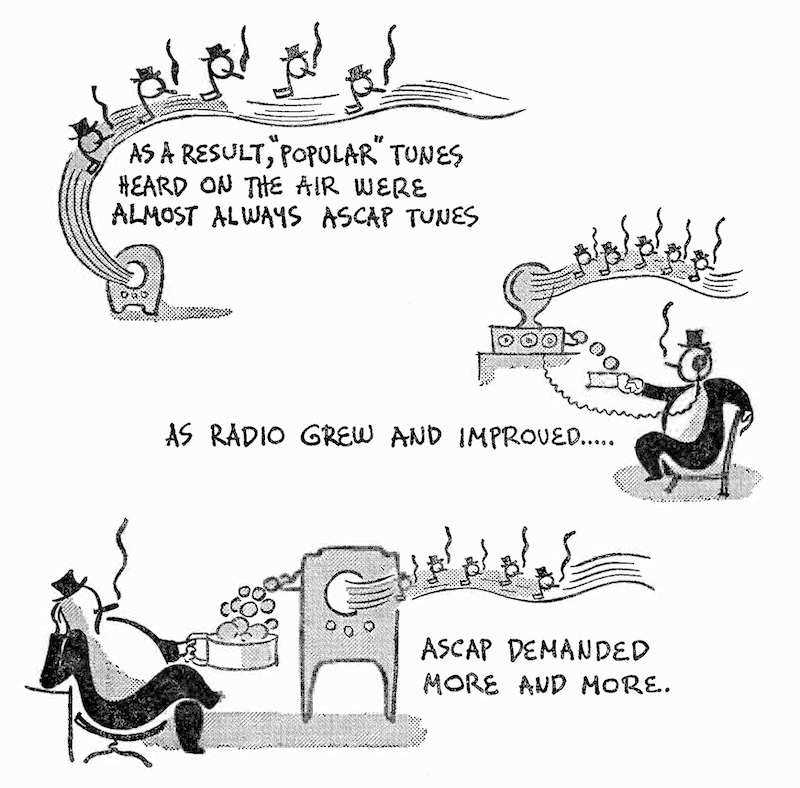
source: “Portrait of a “Protector””, National Association of Broadcasters, 1940
NAB が1940年に発行した BMI 設立に関するブックレット。悪の枢軸 ASCAP という感じでイラストが描かれています。
この NAB は、加盟する放送局に向けて、NAB Reports という機関誌を発行していました。この機関誌上において、1942年NABカーブ策定のいきさつが克明に記録されています。
NAB periodically published the bulletins entitled “NAB Reports” for broadcast stations. These weekly bulletins clearly records the history and background of the long way toward the standardization of the 1942 NAB Standards.
8.1.1 NAB Annual Reports, 1941
まず、1941年5月頃に発行されたと思われる年次報告書に、録音再生カーブに関する記載をみることができます。これが規格標準化のスタートということになります。
1941 edition of NAB Annual Reports (issued probably in May 1951) contains the short report regarding the recording/reproducing standardization – probably the earliest mention of the start of the standardization and its work.
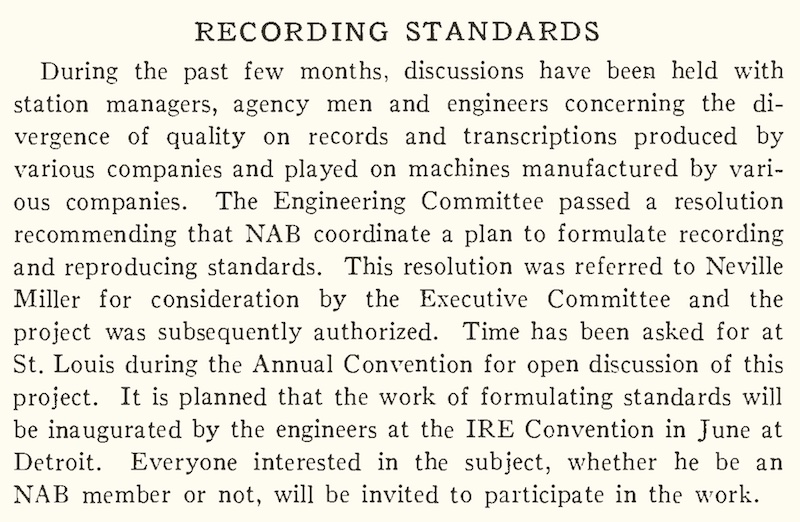
source: “NAB Annual Reports, 1941, p.5”
放送局用トランスクリプション盤における録音再生カーブに関する恐らく初出の記載
probably the first appearance of “Recording Standards” for radio transcription records
During the past few months, discussions have been held with station managers, agency men and engineers concerning the divergence of quality on records and transcriptions produced by various companies and played on machines manufactured by various companies. The Engineering Committee passed a resolution recommending that NAB coordinate a plan to formulate recording and reproducing standards. This resolution was referred to Neville Miller for consideration by the Executive Committee and the project was subsequently authorized. Time has been asked for at St. Louis during the Annual Convention for open discussion of this project. It is planned that the work of formulating standards will be inaugurated by the engineers at the IRE Convention in June at Detroit. Everyone interested in the subject, whether he be an NAB member or not, will be invited to participate in the work.
この数ヶ月もの間、放送局のマネージャ、代理店の人々、エンジニアなどの間で、各社が製造したレコードやトランスクリプション盤を、各社が製造した機器で再生する際の品質のばらつきについて議論が行われてきた。NAB技術委員会では、NABが録音と再生における標準化策定計画を調整するよう勧告する決議を採択した。この決議は Neville Miller 氏に付託され、執行委員会の審議にはかられたのち、このプロジェクトは認可された。セントルイスでの年次大会期間中に、このプロジェクトについて公開討論を行う時期を確保するよう要請された。結果、6月にデトロイトで開催される IRE (Institute of Radio Engineers) の研究会議において、標準規格の策定作業がエンジニアによって開始される予定となっている。このテーマに関心のある者は誰でも(NAB会員・非会員の別を問わず)この作業への参加を歓迎するものである。
NAB Annual Reports, 1941, p.58.1.2 NAB Reports, Vol.9, No.23, June 13, 1941
上で触れられた1941年6月26日デトロイト開催のIREコンベンションについて、6月13日号にも詳報が掲載されています。「各放送局に質問状を送った結果、最大10種類ものイコライザ設定が使われていることが判明し、それだけあっても多種多様なトランスクリプション盤全てにおいて完璧なフラット再生ができていない」というくだりが、状況の深刻さを伝えています。
June 13, 1941 issue of NAB Reports also reports some details on the coming IRE Convention, June 26, 1941 in Detroit. It reads: “as high as ten differnt equalizer settings for reproducing”, and “even with such an elaborate set of equalizers it has not been possible to entirely obtain uniform results”, that describes the state of confusion at the time.
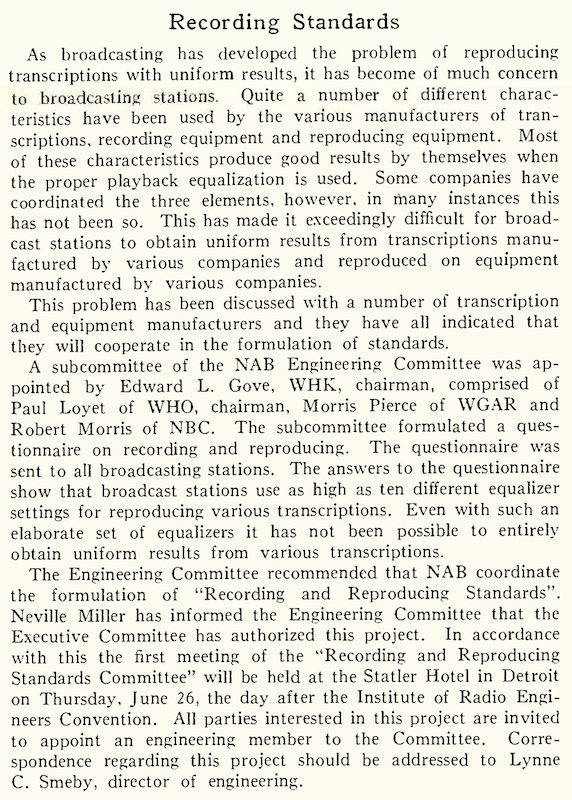
source: “NAB Reports, Vol.9, No.23, June 13, 1941, pp.522-523”
第1回「録音・再生規格委員会」開催を伝える記事
As broadcasting has developed the problem of reproducing transcriptions with uniform results, it has become of much concern to broadcasting stations. Quite a number of different characteristics has been used by the various manufacturers of transcriptions, recording equipment and reproducing equipment. Most of these characteristics produce good results by themselves when the proper playback equalization is used. Some companies have coordinated the three elements, however, in many instances this has not been so. This has made it exceedingly difficult for broadcast stations to obtain uniform results from transcriptions manufactured by various companies and reproduced on equipment manufactured by various companies.
放送の世界において、トランスクリプション盤再生における均一な(フラット再生)結果が得られないという問題が明らかになってきており、これは現在放送局にとって大きな関心事となっている。トランスクリプション盤製造メーカ、録音機器製造メーカ、再生機器製造メーカの間で、あまりにも多くの異なった特性が使用されているのが現状である。再生時に適切なイコライジングを行えば、ほぼ全ての特性の盤から良好な結果を得られる。トランスクリプション盤、録音機器、再生機器をセットにして特性を揃えられるようにしている一部のメーカもあるが、そうではないメーカも少なくはない。このため、各社が製造したトランスクリプション盤を、各社が製造した再生機器で再生する際に、均一な特性での再生を行うことが非常に困難な状況を招いている。
This problem has been discussed with a number of transcription and equipment manufacturers and they have all indicated that they will cooperate in the formulation of standards.
この問題に関して、トランスクリプション盤製造メーカや機器製造メーカなど多くの企業との協議の結果、特性に関する標準規格の策定に協力する、との回答を得ている。
A subcommittee of the NAB Engineering Committee was appointed by Edward L. Gove, WHK, chariman, comprised of Paul Loyet of WHO, chairman, Morris Pierce of WGAR and Robert Morris of NBC. The subcommittee formulated a questionnaire on recording and reproducing. The questionnaire was sent to all broadcast stations. The answers to the questionnaire show that broadcast stations use as high as ten different equalizaer settings for reproducing various transcriptions. Even with such an elaborate set of equalizers it has not been possible to entirely obtain uniform results from various transcriptions.
WHK の Edward L. Gove 議長により、NAB技術委員会の小委員会が設置され、WHO の Paul Loyet 氏、WGAR の Morris Pierce 氏、NBC の Robert Morris 氏を小委員会構成メンバに任命した。当小委員会は録音と再生に関するアンケートを作成し、全放送局に送付した。そのアンケートの結果、トランスクリプション盤再生に際して最大10種類ものイコライザ設定を使用していることが判明した。これだけ多くのイコライザ設定を使用してもなお、さまざまなトランスクリプション盤再生において完全に同等な再生結果を得ることができずにいる。
The Engineering Committee recommended that NAB coordinate the formulation of “Recording and Reproducing Standards”. Neville Miller has informed the Engineering Committee that the Executive Committee has authorized this project. In accordance with this the first meeting of the “Recording and Reproducing Stanrards Committee” will be held at the Statler Hotel in Detroit on Thursday, June 26, the day after the Institute of Radio Engineers Convention. All parties interested in this project are invited to appoint an engineering member to the Committee. Correspondence regarding this project should be addressed to Lynne C. Smeby, director of engineering.
NAB技術委員会は、NABが「録音・再生標準規格」を作成するべく調整すべしと提言を行った。Neville Miller 氏は技術委員会に対し、執行委員会がこのプロジェクトを承認したと報告した。これに伴い、「録音・再生規格委員会」第1回会合が、デトロイトのスタットラーホテルで開催される IRE 会議の翌日、6月26日木曜日に同所で開催されることとなった。このプロジェクトに関心のある方は、委員会メンバとなるエンジニアを推薦されたし。当プロジェクトに関する連絡は、技術ディレクタの Lynne C. Smeby まで。
NAB Reports, Vol.9, No.23, June 13, 1941, pp.522-523「この問題に関して、トランスクリプション盤製造メーカや機器製造メーカなど多くの企業との協議の結果、特性に関する標準規格の策定に協力する、との回答を得ている」という箇所も、標準化に向けて業界全体で協力する雰囲気が作られていたことが伺えます。
The sentence that reads “This problem has been discussed with a number of transcription and equipment manufacturers and they have all indicated that they will cooperate in the formulation of standards” shows there was already an atmosphere that the industry as a whole should work for the standardization.
8.1.3 NAB Reports, Vol.9, No.28, July 18, 1941
そして1941年7月18日号の NAB Reports で、その IRE コンベンションでの成果について報告が行われています。NAB という組織が主導的独善的に標準化を進めるのではなく、あくまで録音再生機器の製造メーカや、トランスクリプション盤を日々利用しているラジオ局エンジニアの声を積極的に取り入れ、NAB が調整役として関与することが記されています。民主的かつ協同的に標準規格を策定しようとする意思が感じられる描写です。
The following report is found in the July 18, 1941 issue of NAB Reports. It describes the result of the first meeting at the IRE Convention in June 26, 1941. It also emphasizes that NAB desires to function as a coordinating medium for the committee, and that the discussion should be conducted by the committee members who are representing all manufacturers and users of transcriptions and equipments. The portray in words surely proves that NAB had the intention of setting the standards in democratic and cooperating way.
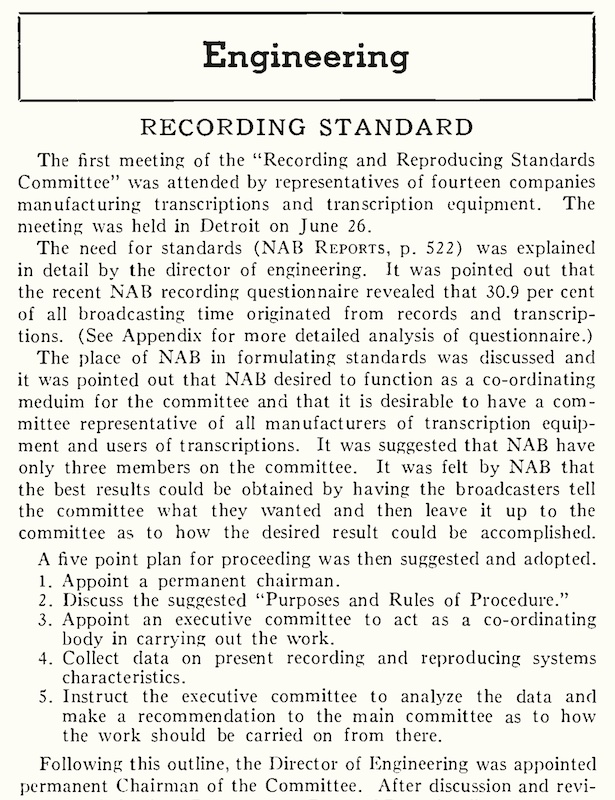
source: “NAB Reports, Vol.9, No.28, July 18, 1941, pp.612-613”
1941年6月26日の「録音・再生規格委員会」第1回会合を伝える記事
The first meeting of the “Recording and Reproducing Standards Committee” was attended by representatives of fourteen companies manufacturing transcriptions and transcription equipment. The meeting was held in Detroit on June 26.
トランスクリプション盤製造メーカおよびトランスクリプション盤機器製造メーカの計14社が参加し「録音・再生規格委員会」第1回会合が催された。当会合は6月26日にデトロイトで開催された。
The need for standards (NAB Reports, p.522) was explained in detail by the director of engineering. It was pointed out that the recent NAB recording questionnaire revealed that 30.9 per cent of all broadcasting time originated from records and transcriptions. (See Appendix for more detailed analysis of questionnaire.)
技術ディレクタから、(録音・再生規格の)標準化の要望(NAB Reports 522ページを参照)について詳細な説明があった。そこでは、NAB によるアンケート実施の結果、ラジオ局における放送時間のうち30.9パーセントが、レコードやトランスクリプション盤再生で占められていることが指摘された。このアンケートの詳細な分析については、当レポートの付録を参照されたし。
The place of NAB in formulating standards was discussed and it was pointed out that NAB desired to function as a co-ordinating medium for the committee and that it is desirable to have a committee representative of all manufacturers of transcription equipment and users of transcriptions. It was suggested that NAB have only three members on the committee. It was felt by NAB that the best results could be obtained by having the broadcasters tell the committee what they wanted and then leave it up to the committee as to how the desired result could be accomplished.
会合ではまず、標準規格の策定における NAB の位置付けが議論された。そこで NAB は委員会の調整媒体として機能することを望んでおり、トランスクリプション盤機器製造メーカとトランスクリプション盤のユーザ(ラジオ放送局のエンジニア)を代表する委員会を設置することが望ましい、との指摘があった。また、NAB から選出される委員は3名のみとすることが提案された。NAB は、放送事業者が何を望んでいるかを委員会に伝え、どのようにすれば望ましい結果を得られるかを委員会に委ねることで、最良の結果が得られると考えている。
NAB Reports, Vol.9, No.28, July 18, 1941, pp.612-613全部訳出するのもどうかと思ったのですが(笑)、トランスクリプション盤向けのEQカーブ標準化の協議が、こんなにも民主的な雰囲気の下に進められていたこと、そしてその経緯が克明に記録され、現代に残っていることは本当に驚きで(日本だとこういう議事録的なものがオープンになることはなさそうな気がしますが、どうなんでしょうね。。。)、ともあれ続けます。
Well, I initially thought I don’t need to quote all of these reports (and translate all of them into Japanese), but I was so impressed the NAB’s great attitude toward the standardization of equalization curves and other physical aspects of transcription discs. I was also deeply impressed with the fact that all of these historical documents are kept intact, enabling us to dig deep (in Japan, it seems to be very hard to follow such historical documentation and reports because sometimes they have not been well archived – it’s just my impression, though). Anyway I continue here.
A five point plan for proceeding was then suggested and adopted.
- Appoint a permanent chairman.
- Discuss the suggested “Purposes and Rules of Procedure.”
- Appoint an executive committee to act as a co-ordinating body in carrying out the work.
- Collect data on present recording and reproducing systems characteristics.
- Instruct the executive committe to analyze the data and make a recommendation to the main committee as to how the work should be carried on from there.
そして、5つのポイントからなる進行計画が提案され、採択された。
- 常任委員長を任命すること。
- 提案された「目的と手続きの規則」について討議すること。
- 作業遂行における調整機関として執行委員会を任命すること。
- 現在の記録・再生システムの特性についてデータを収集すること。
- データを分析し、その結果今後どのように作業を進めるべきかについて、主委員会に勧告するよう、執行委員会に対し指示すること。
その結果、採択された「手続きの目的と規則」が次に記されています。トランスクリプション盤の録音再生機器製造メーカ、およびトランスクリプション盤利用者のみが投票権を持つことで、特定のラジオ局が有利にならないように配慮されていることが伺えます。
As a result of the adopted proceeding plan, “Purpose and Rules of Procedure” was adopted. These lines may reveal some considerations – by giving the right to vote primarily for transcription disc manufacturers, recording equipment manufacturers and transcription disc users. This consideration may be aimed to prevent a specific radio station from gaining some benefitical position.
Following this outline, the Director of Engineering was appointed permanet Chairman of the Committee. After discussion and revision, the following “Purpose and Rules of Procedure” were adopted by the committee.
以上の進行計画に従い、(NAB)技術ディレクタが当委員会の常任委員長として任命された。そして議論や改訂が行われたのち、以下の「手続きの目的と規則」が当委員会によって採択された。
1. The task of the committee is to formulate “Recoding and Reproducing Standards” that will tend to bring about uniform quality of reproduction of transcriptions with a minimum number of equipment adjustments on the reproducing system.
1. 本委員会の任務は「録音・再生標準規格」の策定である。それは、トランスクリプション盤の再生機器に対し最小限の調整を行えば実現可能な、再生品質の均一化・統一化を進めるものである。
2. All companies interested in the manufacturing of disc recordings, the manufacture of disc recording equipment, the manufacture of disc reproducing equipment, the use of disc recordings, and others properly interested in the subject are entitled to membership on the committee.
2. トランスクリプション盤の製造メーカ、トランスクリプション盤録音機器の製造メーカ、トランスクリプション盤再生機器の製造メーカ、トランスクリプションを利用する企業、その他本件に興味のある者は全て、当委員会のメンバとなる資格を有する。
3. No company shall have more than one vote in any of the proceedings of the committee and this shall be cast by the regularly designated representative of that company. In the absense of the regularly designated member, a duly authorized alternate may participate and vote for the regular member.
3. (当委員会メンバである)いかなる企業も、委員会のいかなる手続きにおいても1票のみの投票権しか有してはならず、その投票権は各企業によって正規に指名された代表者によって行使されるものとする。正規代表者が不在の場合は、権限を与えられた代理人が参加し、正規代表者に代わり投票できるものとする。
4. Technical advisors to members of the committee may participate fully in meeting discussions; however, they will have no vote in the proceedings.
4. 委員会々員の技術顧問は、会議における議論に全面的に参加可能とするが、議決における投票権は持たないものとする。
5. No individual broadcasters will be entitled to a vote in the proceedings of the commmittee. The broadcasters as a whole will be entitled to representation through three members duly appointed by Neville Miller, President of the National Association of Broadcasters.
5. 個々の放送事業者は、委員会の手続きにおいて投票権を有しないものとする。放送事業者全体は、NAB 会長である Neville Miller 氏が正式に任命した3人の委員を通じて代表権を持つ。
6. The chariman of the committee is not entitled to vote except in case of a tie.
6. 当委員会の委員長は、投票結果が同数の場合を除き、投票権を有しないものとする。
7. It is clearly understood that participation in the work of the committee does not bind any individual or company to the formulated recommended standards.
7. 当然ながら、参加する個人や企業が当委員会の活動に参加することで、策定された推奨標準規格(への準拠)に拘束されるものではない。
NAB Reports, Vol.9, No.28, July 18, 1941, pp.612-613その後、委員会では、現在の録音再生手法に関するデータを収集すべく、録音再生機器を製造する各社に送るアンケートの作成と分析を行う小委員会設置を決定したそうです。その小委員会の構成メンバとして、NBC の Robert Morris 氏を委員長とし、CBS の Howard A. Chinn 氏、World 社の C. Lauda, Jr. 氏、Bell Telephone Labs の E.T. Mottram 氏、Columbia Recording の I.P. Rodman 氏が任命されたとあります。
Then the report continues: “The committee decided that a sub-committee should be appointed for the purpose of formulating and analyzing a questionnaire to be sent to manufacturers in order to obtain data on present recording practices. The following were appointed to the sub-committee: Howard A. Chinn, CBS; C. Lauda, Jr., World; Robert Morris, NBC, Chariman; E.T. Mottram, Bell Telephone Labs; I.P. Rodman, Columbia Recording.”
そして、次回会合は1941年10月24〜25日にニューヨークで開催されるアメリカ音響学会の秋大会にあわせて行われることが決定されました。
And it was decided to hold the next meeting of the main committee coincidental with the Fall meeting of the Acoustical Society of America in New York City, October 24, 25, 1941.
当レポートの締めくくりとして、この第1回会合に参加した面々が記されていおり、これ自体が非常に興味深いです。さまざまな録音再生規格を持つ企業が、恐らくは我がEQ技術を標準規格として選出したい、と考えて参加していたのかもしれません(し、そうでないかもしれません)。中には、本稿前半で紹介した、定振幅録音再生の普及を狙っていたであろう、Brush Development 社の S.J. Begun 氏の名前や盟友 Astatic Corp. の社名も見えますし、縦振動トランスクリプションを推進していた Bell Labs と World Broadcasting System 社の名前も確認できます。
The end of the report is the attendance list, which itself is very interesting. Probably every single attendant with each recording/reproducing technology would seek to vote their own equalization characteristic as a standardized one – or not. The list includes Brush Development (advocator of constant amplitude recording and reproducing) and its ally Astatic Corp., as well as Bell Labs and World Broadcasting System (advocator of vertical-cut recording and reproducing).
Attendance list:
- S.J. Begun, Brush Development;
- J.R. Bird, Astatic Corp.;
- E.P. Carter, Recording Consultant;
- Howard A. Chinn, CBS;
- R.C. Curtis, Associated Music Publishers;
- Walter Fagen, Memovox;
- C. Lauda, Jr., World Broadcasting System;
- P.A. Loyet, WHO-WOC;
- M.R. Mitchell, WJR;
- Robert Morris, NBC;
- E.T. Mottram, Bell Telephone Labs;
- Clarence Pell, Radio Devices;
- Morris Pierce, WGAR;
- I.P. Rodman, Columbia Recording;
- F.C. Schmid, Electrical Research Products;
- Carl E. Smith, United Broadcasting Co.;
- Lynne C. Smeby, NAB, Chairman.
8.1.4 Appendix: NAB Recording Questionnaire, NAB Reports, Vol.9, No.28, July 18, 1941
さらに、当レポートの付録として、各放送局に送られ回収されたアンケートの集計結果が掲載されています。回答は182のラジオ局から寄せられたとのことです。1941年当時、まだ録音再生標準EQカーブが策定される前に、ラジオ局でディスク再生がどのように行われていたか、またアセテート盤録音においてプリエンファシスの使用など、それらの統計を示す貴重なデータとなっています。
Furthermore, this report has an appendix, tabulation of questionnaire results entitled “NAB Recording Questionnaire”, answered from 182 radio stations. This appendix is one of the invaluable examples of statistical data – what percentage of U.S. radio stations in 1941 used lateral and vertical transcriptions, and what percentage of them used/favored pre-emphasis in instantaenous recordings.
まずは再生機器側の集計結果です。
First, the aggregate result of reproducing aspect.
- How many hours per week are lateral transcriptions used? 4096.99
- How many hours per week are vertical transcriptions used? 1512.16
- How many hours per week are phonograph records used? 1478.16
Assuming an average of 18 hours of broadcasting per day the 182 stations broadcast 22,932 hours per week. The total number of hours per week transcriptions or records are used is 7087.37, therefore 30.9% of broadcasting is from records or transcriptions. Of this time 57.8% is by lateral transcriptions, 21.3% by vertical transcriptions and 20.9% by phonograph records.
- 1週間で横振動トランスクリプション盤を放送で使用する時間 4096.99
- 1週間で縦振動トランスクリプション盤を放送で使用する時間 1512.16
- 1週間で民生用レコードを放送で使用する時間 1478.16
182のラジオ局が、それぞれ1日平均で18時間放送していると仮定すると、1週間での全放送局の全放送時間は 22,932時間となる。そのうち、トランスクリプション盤や民生用レコードの再生に費やされる時間は 7087.37時間となり、つまり全放送時間のうち 30.9% がレコードやトランスクリプション盤の再生でまかなわれていることになる。このうち 57.8% が横振動トランスクリプションによる再生、21.3% が縦振動トランスクリプションによる再生、そして残る 20.9% が民生用レコードによる再生となる。
NAB Reports, Vol.9, No.28, July 18, 1941, pp.612-613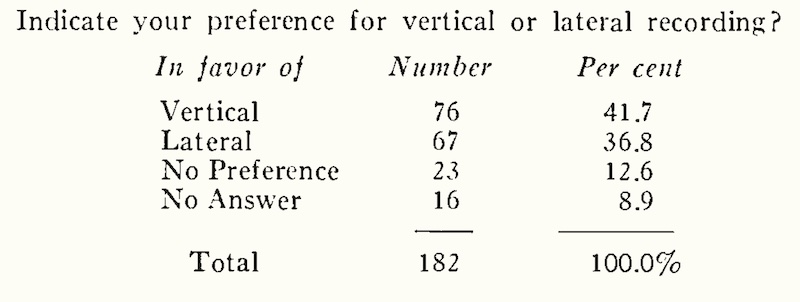
source: “NAB Reports, Vol.9, No.28, July 18, 1941, pp.612-613”
182のラジオ局に行ったアンケート結果
縦振動トランスクリプション盤が依然根強く使われている使われている
また、横振動トランスクリプションの方を好むと答えたラジオ局は、「ラジオ局が横振動盤用の機器しか持っていないから」「横振動盤の方が音源のバリエーションが多いから」といった理由をあげていたとのことです。
Also, radio stations that answered the preference of lateral recording gave some reasons like: “the station had only lateral equipment”, or “a wider selection of records is available on laterals”.
一方、アンケート結果では縦振動トランスクリプションを好むという回答の方が多く、ラジオ局業界における縦振動盤への根強い支持が伺えます。これが、1942年に策定されることになる NAB 標準規格において、縦振動用カーブと横振動用カーブの両方が掲載されている理由と考えられます。
On the other hand, it also shows that larger percentage of radio stations prefers vertical transcriptions, indicating solid popularity in the radio industry. This would be the reason why the soon-to-come 1942 NAB Standards have recording curves both for lateral and vertical transcriptions.
続いて、録音機器側の集計結果です。
Next, the aggregate result of recording aspect.
- How many hours per week are recorded? 695.25
This is an average per station per week of 3.82 hours. 146 or 80.2% of the stations indicated that they have recording equipment.
- 1週間で自社で録音したアセテート盤を放送で使用する時間 695.25
これは、各ラジオ局が1週間に平均して3.82時間アセテート盤再生に費やしている計算になる。また、146のラジオ局、つまり 80.2% のラジオ局が、自社で録音機材を所有していると答えている。
NAB Reports, Vol.9, No.28, July 18, 1941, pp.612-613さらに、録音時のプリエンファシスについてどう思うか、のアンケート集計結果も掲載されています。ここでいう「プリエンファシス」とは、低域のターンオーバー(500Hz 以下が定振幅特性、500Hz 以上が定速度特性)ではなく、Orthacoustic などに代表される高域プリエンファシスや重低域プリエンファシスのことを指していると考えられます。結果、58.3% のラジオ局が、「標準化されるのであれば」プリエンファシスに賛成、という反応を示しています。
Also, a result of preference for pre-emphasis is included. This “pre-emphasis” refer to bass/treble pre-emphasis like Orthacoustic curve, not the bass turnover (constant amplitude below 500Hz, constant velocity above 500Hz). Anyway, 58.3% of the radio stations answered yes, “if it was standardized”.
Many of the “yes” answers were qualified by the statement that the person was in favor of pre-emphasis if it was standardized.
「プリエンファシスに賛成」という回答の多くには、「もしプリエンファシスが標準化されることになれば」賛成である旨が記されていた。
NAB Reports, Vol.9, No.28, July 18, 1941, pp.612-613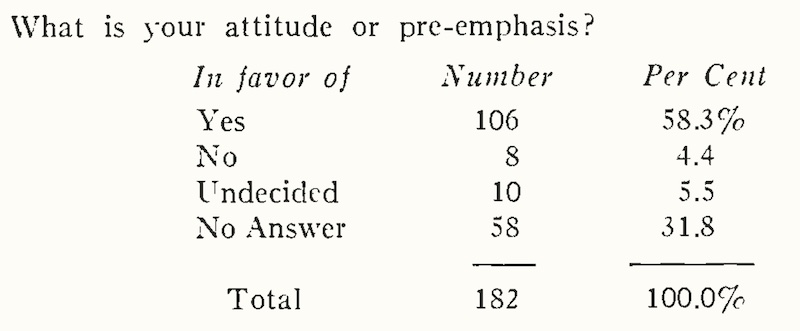
source: “NAB Reports, Vol.9, No.28, July 18, 1941”
182のラジオ局に行ったアンケート結果
プリエンファシスの採用に肯定的な意見が多い
8.1.5 NAB Reports, Vol.9, No.34, August 29, 1941
次に録音・再生規格委員会の動きを伝えるのは1941年8月29日号で、8月20日に行われた執行委員会の模様が伝えられています。10月に開催される委員会に向けて、ラジオ局に対して行ったアンケートのように、今度は製造メーカに対して行うアンケートについて議論された他、標準規格がどうあるべきか、についても議論が行われたようです。
Next issue that reports the ongoing status of the Recording and Reproducing Standards Committee is Vol.9, No.34, August 29, 1941 issue. This issue reports the progress at the Executive Committee meeting held on August 20, 1941. Like the questionnaire to radio stations, another questionnaire was formulated and it was to be sent to manufacturers. Also, categorization of the entire standards was discussed.
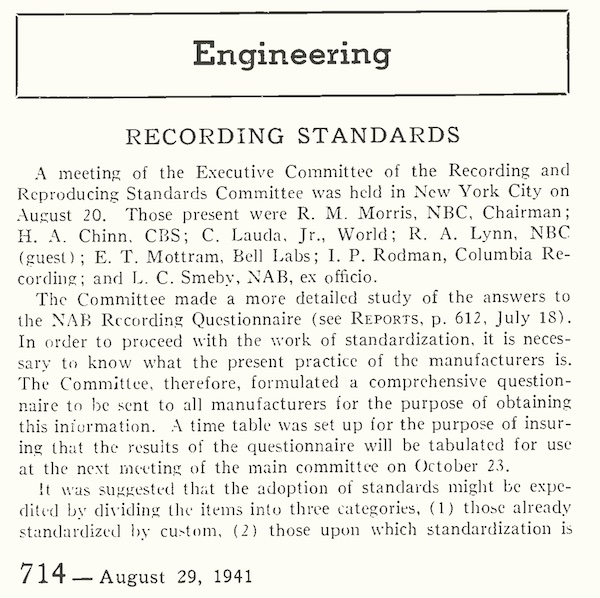
source: “NAB Reports, Vol.9, No.34, August 29, 1941, p.714”
1941年8月20日に行われた「録音・再生規格委員会」執行委員会の模様を伝える記事
A meeting of the Executive Committee of the Recording and Reproducing Standards Committe was held in New York City on August 20. Those present were R.M. Morris, NBC, Chairman; H.A. Chinn, CBS; C. Lauda, Jr., World; R.A. Lynn, NBC (guest); E.T. Mottram, Bell Labs; I.P. Rodman, Columbia Recording; and L.C. Smeby, NAB, ex officio.
1941年8月20日、ニューヨークにおいて、録音・再生規格委員会の執行委員会が開催された。出席者は以下の通り。委員長 R.M. Morris (NBC)、 H.A. Chinn (CBS)、 C. Lauda, Jr. (World)、 R.A. Lynn (NBC, ゲスト参加)、 E.T. Mottram (ベル研)、 I.P. Rodman (Columbia Recordings)、 L.C. Smeby (NAB, 職務上のメンバ)。
The Committee made a more detailed study of the answers to the NAB Recording Questionnaire (see Reports, p.612, July 18). In order to proceed with the work of standardization, it is necessary to know what the present practice of the manufacturers is. The Committee, therefore, formulated a comprehensive questionnaire to be sent to all manufacturers for the purpose of obtaining this information. A time table was set up for the purpose of insuring that the results of the questionnaire will be tabulated for use at the next meeting of the main committee on October 23.
NAB録音アンケート(7月18号のp.612を参照のこと)に対する回答について、より詳細な検討を行った。標準化作業を進めるためには、製造メーカの現在行っている実態を知ることが必要となる。そこで委員会は、そういった実態を知るために、全メーカに送付する包括的なアンケートを策定した。このアンケートの結果を次回10月23日の委員会で使用するべく集計を確実にする目的で、タイムテーブルが設定された。
It was suggested that the adoption of standards might be expedited by dividing the items into three categories, (1) those already standardized in custom, (2) those upon which standardization is important, (3) those which fall into the class of “good engineering practice.”
また、規格自体を以下の3カテゴリーに分割することで、規格採択が促進されるのではないか、という提案が行われた。 (1) すでに慣習として標準化されているもの、 (2) 標準化されることが重要であるもの、 (3) 「エンジニアリング実践規範」のクラスに属するもの、この3つのカテゴリーである。
NAB Reports, Vol.9, No.34, August 29, 1941, p.714また、この8月時点で、委員会メンバが58名にまで増えており、トランスクリプション盤の録音・再生標準規格策定におけるほぼ全ての重要メーカ・人物が勢揃いしていることが伺えます。RCA や Columbia といったレコード業界最大手はもちろん、本稿 Pt.5 で紹介した各種トランスクリプション盤製造レーベルも、本稿 Pt.6 で紹介したハーバード大教授の F.V. Hunt 氏や、アセテート録音機の Presto Recording Corp. の社長、ラッカー盤(アセテート盤)製造メーカ(Audio Devices Inc.)も、名を連ねています。
As of this August 1941, the number of the Committee members already reaches at fifty-eight, “practically all the leaders in the field” including phonograph leading companies like RCA and Columbia, of course. Almost all electrical transcription manufacturers (as seen on the Pt.5 article), F.V. Hunt of Harvard University (as seen on the Pt.6 article), instantaneous disc recorder manufacturer Presto Recording Corp. (also on Pt.6), and lacquer disc manufacturer Audio Devices Inc. (also on Pt.6), etc.
また、顔ぶれをみると、一部の市販レコード製造販売レーベル(Musicraft レーベル)のエンジニアも参加しているのが興味深く、放送局用トランスクリプション盤の録音再生特性に関する技術を市販レコードにも転用するべく調査目的で潜入した(笑)ということなのか、はたまたトランスクリプション盤製造に参入しようとしていたということなのかもしれません。
It is also interesting to find the name of the engineer working at the record label for consumer market (Musicraft label) in the list. As far as I know, Musicraft label never released electrical transcription discs, so the label either wanted to study the recording/reproduccing characteristic for radio transcriptions, or intended to enter the transcription manufacturing industry 🙂
The Recording and Reproducing Standards Committee now has a membership of 58 including practically all the leaders in the field. The membership is as follows:
録音・再生規格委員会は現在、実質的にこの分野のリーダを含む58名の委員で構成されている。メンバは以下の通りである。
- Alliance Mfg. Co., P.M. Turner, Chief Engineer;
- Altec Service Corp., J.H. Littenberg;
- Associated Music Publishers, K.R. Smith, Chief Engineer;
- The Astatic Corp., J.R. Bird, Chief Engineer;
- Audio Devices, Inc., C.J. LeBel, Chief Engineer;
- Bell Telephone Laboratories, Inc., E.T. Mottram;
- Blackett-Sample-Hummert, Inc., Henry Rahmel, Studio Manager;
- David Bogen Co., Inc., Joseph B. Hersh, General Manager;
- Broadcast Productions, John Stamford, Owner;
- The Brush Development Co., Dr. S.J. Begun;
- C.K. Recorders, Pliny O. Clark, Manager;
- Central Broadcasting Co., WHO, P.A. Loyet, Technical Director (Representing NAB);
- Christensen Recording Studios, Carle A. Christensen, Owner;
- Columbia Broadcasting System, Inc., Howard A. Chinn (Representing NAB);
- Columbia Recording Corporation, I.P. Rodman, Director of Engineering;
- Electrical Research Products, F.C. Schmid, Licensing Engineer;
- FM Broadcasters, Inc., Samuel Waite;
- Federal Recorder Co., Inc., Jack Siegel, Head, Recording Division;
- Federal Transcribed Programs, Inc., A. Ralph Steinberg, President;
- Film Associates, Ray Arn, Ornwer;
- General Communication Products Company, R.J. Thompson, Chief Engineer;
- General Sound Corporation, Edgar P. Kampf, President;
- Gray Manufacturing Co., H.T. Stenhammer, Director of Research;
- Lillian Gurdoni Radio Productions, Stan Gurdoni, Recording Engineer;
- Harvard University, Frederick V. Hunt;
- Hollywood Recording Co., John Hirsch, Owner;
- Illinois Educational Sound Service, R.W. Damron, Owner;
- John D. Keating, John D. Keating, Owner;
- Kermit-Raymond Corporation, Raymond R. Green, General Manager;
- Mirror Record Corporation, Paul K. Trautwein;
- C.P. MacGregor Transcription Company, Arthur Q. Felthausen, Chief Engineer;
- Memvox Inc., Sigurd A. Sollie, Sales Manager;
- Miller Bros. Recording Studio, Ross J. Miller, Partner;
- Musicraft Records, Inc., Earl Carter, Engineer;
- National Association of Broacdasters, Lynne C. Smeby, Director of Engineering;
- National Broadcasting Company, Inc., Robert M. Morris, Business Manager Radio Recording;
- Pacific Sound Equipment Co., Inc., Robert G. Metzner, President;
- Permo Products Corporation, F.M. Hummel, Sales Manager;
- Photo & Sound Inc.;
- Poinsettia Inc., Earl P. Carter;
- Presto Recording Corporation, George J. Saliba, President;
- B.A. Proctor Company, Inc., B.A. Proctor, President;
- Radiad Service;
- RCA Manufacturing Co., Inc.;
- E.T. Dickey, (Representing RMA);
- Radio Features of America, Oliver W. Nicoll, Director Programs and Production;
- Reeves Sound Studios, Inc. Hazard E. Reeves, President;
- Rek-O-Kut Corporation, George Silber;
- Robinson Recording Laboratories;
- J.P. Seeburg Corporation, Hugh Davis, Engineering Department;
- Shure Brothers, Benjamin B. Bauer, Chief Engineer;
- Star Record Company;
- Technisonic Recording Lab., James M. Althouse, Chief Engineer;
- United Artists Bureau, R.B. Eaton, General Manager;
- Universal Microphone Co., Ltd., Ralph L. Power, Ph.D, Promotion Manager;
- Thomas J. Valentino, Inc., T.J. Valentino, Sales Manager;
- Western Sound & Electric Lab., Inc., Edward M. Dieringer, President;
- WGAR, Morris Pierce, Chief Engineer, (Representing NAB);
- World Broadcasting System, Charles Lauda, Jr., Plant Manager;
Chairman – Lynne C. Smeby.
Executive Committee – Howard A. Chinn; C. Lauda, Jr.; Robert M. Morris, chairman; E.T. Mottram; I.P. Redman.
NAB Reports, Vol.9, No.34, August 29, 1941, p.7148.1.6 Communications, September 1941
まさにこの標準化作業が進むさなか、執行委員会のメンバであり、同時に NAB を代表して参加している Howard A. Chinn (CBS) 氏が、Communications 誌の1941年9月号に “Standards for Electrical Transcriptions” を寄稿しており、この標準化作業に関する背景が語られています。
Amid the Standards Committee was working for standardization, Howard A. Chinn of CBS, a member of Executive Committee and representing NAB, submitted his article “Standards for Electrical Transcriptions” for the Communication magazine, Sep. 1941 issue, describing the background of the works by the Standards Committee and the standardization process.
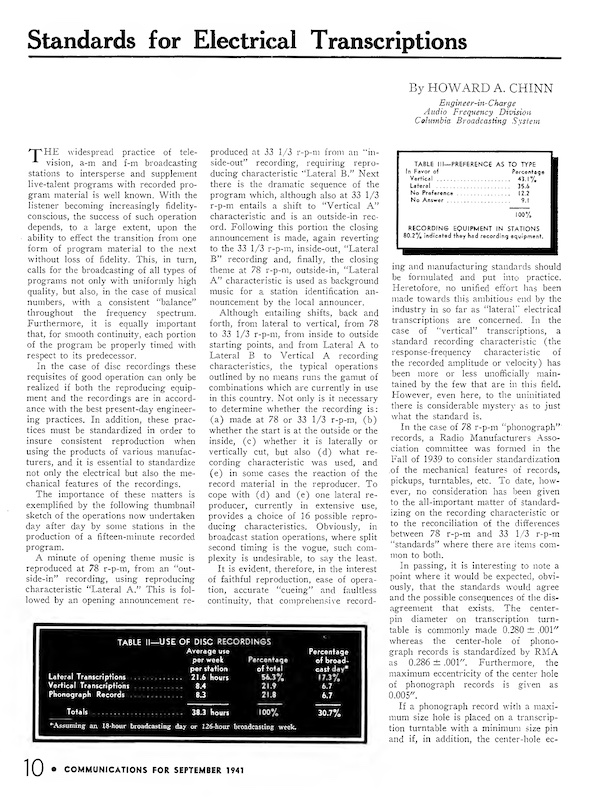
source: “Standards for Electrical Transcriptions”, Howard A. Chinn, Communications, September 1941, Vol.21, No.9, pp.10-11, 33.
Communications 誌に掲載された、録音再生規格委員会執行委員の Chinn 氏による記事
ここでは全文を翻訳・掲載することは控えますが、以下、興味深い箇所についてのみ引用します。特に、ラジオ局で放送目的で使われるからこそ、オペレータの煩雑な作業を軽減する目的で標準化が強く望まれていることが伺える箇所が、非常に重要であると思います。
I will not quote (translate) the entire article here, except several parts I think very interesting. The exemplification part (of daily operations at radio stations) is the most interesting part for me.
The importance of these matters (standardizing both electrical and mechanical features of the recordings) is exemplified by the following thumbnail sketch of the operations now undertaken day after day by some stations in the production of a fifteen-minute recorded program.
これら(録音における電気的側面と機械的側面の標準化を行うこと)の重要性は、いろんな放送局において15分間の放送番組を録音制作する際に日々行われている、次のような作業スケッチとして例示することができよう。
A minute of opening theme music is reproduced at 78 r-p-m, from an “outside-in” recording, using reproducing characteristic of “Lateral A.” This is followed by an opening announcement reproduced at 33 1/3 r-p-m from an “inside-out” recording, requiring reproducing characteristic “Lateral B.” Next there is the dramatic sequence of the program which, although at 33 1/3 r-p-m entails a shift to “Vertical A” characteristic and is an outside-in record. Following this portion the closing announcement is made, again reverting to the 33 1/3 r-p-m, inside-out, “Lateral B” recording and, finally, the closing theme at 78 r-p-m outside-in, “Lateral A” characteristic is used as background music for a station identification announcement by the local announcer.
冒頭のオープニングテーマ曲の1分間は、外周スタート(アウトサイド・イン)の78回転横振動盤を「横振動A」の再生特性で再生される。続いて、番組のオープニングアナウンスが内周スタート(インサイド・アウト)の33 1/3回転横振動盤で「横振動B」再生特性で再生される。続いて番組メインのドラマ部分であるが、これは 33 1/3回転かつアウトサイド・インの縦振動盤で、「縦振動A」の再生特性で再生される。その後、番組のクロージングアナウンスはインサイド・アウトの 33 1/3回転横振動盤を「横振動B」特性で記録されたものに戻り、最後に、アナウンサーによる放送局識別アナウンスのBGMとして、クロージングテーマ曲が 78回転横振動盤「横振動A」特性のものを再生することで演奏される。
Although entailing shifts, back and forth, from lateral to vertical, from 78 to 33 1/3 r-p-m, from inside to outside stating points, and from Lateral A to Lateral B to Vertical A recording characteristics, the typical operations outlined by no means runs the gamut of combinations which are currently in use in this country. Not only is it necessary to determine whether the recording is: (a) made at 78 or 33 1/3 r-p-m, (b) whether the start is at outside or the inside, (c) whether it is laterally or vertically cut, but also (d) what recording characteristic was used, and (e) in some cases the reaction of the record material in the reproducer. To cope with (d) and (e) one lateral reproducer, currently in extensive use, provides a choice of 16 possible reproducing characteristics. Obviously, in broad cast station operations, where split second timing is the vogue, such complexity is undesirable, to say at the least.
横振動から縦振動から、78回転から 33 1/3回転へ、内周スタートから外周スタートへ、横振動A記録特性から横振動B記録特性や縦振動記録特性Aへ、といった変更が必要となるわけだが、いま概説したような典型的なオペレーションは、実は現在わが国で用いられている組み合わせを全て網羅できていない。 (a) レコード盤が 78回転か 33 1/3回転か、 (b) 外周スタートか内周スタートか、 (c) 横振動記録か縦振動記録か、だけにとどまらず、 (d) その盤で使用された録音特性は何か、そして (e) 再生機器におけるレコード盤の素材の反応、 についてまでも判断しなければならない。この (d) や (e) に対応するために、ある広く使われている横振動ディスク用再生機器では、16種類の再生特性を選択可能になっている。放送局におけるオペレーションでは、コンマ何秒のタイミングでの運用が流行となっており、明らかにこのような(操作上の)複雑性は、控えめに言っても望ましいものとは言えない。
Standards for Electrical Transcriptions, Communications, Sep. 1941, Vol.21, No.9この「(e) 再生機器におけるレコード盤の素材の反応」というのがちょっと分かりにくいですが、スクラッチフィルタの適用量についてのことでしょう。シェラック盤であればサーフェスノイズが多めなので、中高域はロールオフさせる、ヴィニライト盤であればサーフェスノイズは少なめなので、フィルタは適用しない、など。
This line “(e) the reaction of the record material in the reproducer” is not straightforward somehow, but it is related to scratch filters: using filters for shellac records (that would produce innevitable amount of surface noise); not using filters for vinylite records; etc.
さらに、1939年秋、RMA (Radio Manufacturers Association, 無線機器製造業者協会) の委員会において、レコード盤の機械的側面(センターピンホールのサイズ、ピックアップの規格、ターンテーブルの規格など)の標準化が試みられたことがあったものの、録音特性についての検討、また78回転盤と33 1/3回転盤の規格の違いの調整は何の検討もされていないままである、と書かれています。
Another interesting story told in this article was the fact that “RMA (Radio Manufacturers Association) committee was formed in the Fall of 1939 to consider standardization of the mechanical features of records, pickups, turntables, etc.”. However, as the article continues, “no consideration has been given to the all-important matter of standardizing on the recording characteristic or to the reconciliation of the differences between 78 r-p-m and 33 1/3 rpm standards where there are items common in both”.
また、アセテート録音機の普及により、各社さまざまな独自規格、いうなれば「擬似標準規格」のようなもので運用している現状は望ましくなく、業界全体での標準規格策定が望まれている、と、NAB の録音・再生規格委員会が設立された背景について解説されています。
Also, with the advent of instantaneous recording equipment in the industry (as well as schools and advertising agencies), it is not desirable that each manufacturer, station and individual operating with his/her own standards, or “quasi-standards”. So this article stresses the importance of the standardization, in order to correct such situation. With such a background, NAB Recording and Reproducing Standards Committee was formed.
そして、本稿前半でみてきたような、録音・再生規格委員会と執行委員会での作業の概要説明が記されたのち、以下の印象的な言葉で締めくくられています。
After the brief description of the works by the Committee and the Executive Committee (as we have seen above), this article impressivly concludes with the following paragraphs.
It is the aim of the Recording and Reproducing Standards Committee to formulate standards of good engineering practice covering all aspects of the recording and manufacture of electrical transcriptions upon which agreement can be reached. Furthermore, an effort will be made to reduce the number of variables to a minimum with the view to simplifying the users’ problem of handling the record. Finally, an attempt will be made to correlate electrical transcriptions and phonograph record standards wherever possible.
当「録音・再生規格委員会」の目的は、トランスクリプション盤の録音と製造におけるあらゆる側面を網羅し、かつ合意に達しうる、エンジニアリング実践規範の標準規格を策定することである。さらに、レコード盤の取り扱いにおける利用者の問題を単純化すべく、考えるべき変数の数を最小限に減らす努力を行うものである。そして最後に、トランスクリプション盤の規格と市販のレコード盤の規格を、可能な限り相互に関連づけるべく試みるものである。
The successful accomplishment of these aims will result in disc recordings that can be freely exchanged by all parties adhering to the standards with the assurance that the material will be faithfully reproduced and that the full advantage of modern, high-fidelity disc recordings is realized. This happy culmination of the project is contingent, of course, upon a continuance of the spirit of cooperation that has been manifested by those who have already taken an active part in the work and by those who have yet to be called upon. It is hoped that in spite of the many more urgent matters engaging the attention of practically everyone that enough time will be found to insure the success of this undertaking.
これらの目的が達成された暁には、盤に記録された音が忠実に再生され、現代の高音質レコードの利点を充分に活用できる、それらが保証されることになり、規格に準拠する全ての関係者の間で自由に交換可能になる、そんなディスク録音の世界が実現することになる。もちろんながら、本プロジェクトにおいてそのような幸せの絶頂が達成できるかは、本プロジェクト作業にすでに積極的に参加している人々や、まだ参加を打診されていない人々の間で、協調・協同の精神が継続するか、にかかっている。実質的に全ての人の関心を集める多くの緊急課題がある状態ではあるが、本プロジェクトの成功に向けて充分な時間が確保されることが望まれる。
Standards for Electrical Transcriptions, Communications, Sep. 1941, Vol.21, No.9そして、最後の重要な言及、「トランスクリプション盤の規格と市販のレコード盤の規格を、可能な限り相互に関連づける」試みは、最終的には第二次大戦後、マイクログルーヴ時代に入ってから、1954年2月の RIAA = 1953 NARTB によって結実することになります。
The last important mention, an attempt to “correlate eletrical transcriptions and phonograph record standards whereever possible” would eventually come to fruition as Feb. 1954 RIAA Standards (= 1953 NARTB Standards) after the WWII, in the “microgroove” years.
8.1.7 NAB Reports, October to December, 1941
この後、どのように録音・再生標準規格が策定されていくか、10月の第2回会合でどんな議論が行われたのか、もちろん読んでみたいところなのですが、どんなに検索しても、NAB Reports の 1941年10月3日号(Vol.9, No.39)を最後に、1941年10月〜12月に発行された号がオンラインでなぜか見つけられませんでした。
I was excited reading these reports as shown above. Of course I wished continue reading other reports that should be on the following issues of NAB Reports. However, I found out that the issues from Oct. to Dec. 1941 were not available anywhere in the internet. The last 1941 issue available was Oct. 3, 1941 (Vol.9, No.39).
そこで、Nicholas Bergh さんのアドバイスを元に、1941年1月〜10月3日号をスキャンして公開してくれている(つまり原本を所有されている)、メリーランド大学図書館に直接問い合わせをしてみました。
So, based on the advice from Nicholas Bergh-san, I tried to contact the University of Maryland College Park via email – the organization that scanned, digitized and contributed for public online access of Jan.-Sep. 1941 issues of NAB Reports.
そうしたら、なんと!オンラインで欠落していた1941年10月10日号 (Vol.9, No.40) 〜 12月26日号 (Vol.9, No.51) の PDF を共有していただけました。担当者の James Michael Baxter さん、本当にありがとうございます!
… And bingo! They kindly provided me the missing pieces, digitized PDF copy of NAB Reports – from Vol.9, No.40 (Oct. 10, 1941) to Vol.9, No.51 (Dec. 26, 1941)! Thank you so much James Michael Baxter-san, Processing, Reference & Outreach Assistant at University of Maryland!
8.1.8 NAB Reports, Vol.9, No.41, October 10, 1941
というわけで、1941年10月10日号 (Vol.9, No.41) のレポートを(興奮気味に)見ていきましょう。
Well, now we’re going to continue reading article from the missing issues with excitement. The following is the report on Vol.9, No.41 (Oct. 10, 1941).
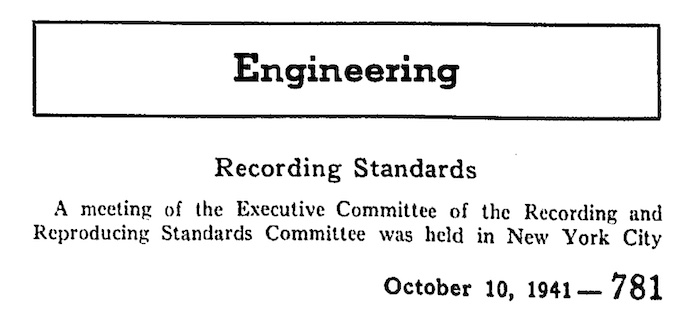
source: “NAB Reports, Vol.9, No.41, October 10, 1941”, p.781
1941年10月7日に行われた「録音・再生規格委員会」執行委員会の模様を伝える記事、の冒頭
A meeting of the Executive Committee of the Recording and Reproducing Standards Committee was held in New York City on October 7. The Executive Committee finished a report to be submitted to the main committee at a meeting in New York City October 23, at the Pennsylvania Hotel. The report is the culmination of several months analysis and the study of recording practices to determine which items are at present standard by usage, and which items require further study. The Executive Committee will recommend to the main committee that standards be adopted at this time on 14 different items. These items are as follows:
10月7日、ニューヨークにて録音・再生規格委員会の執行委員会が開催された。同執行委員会は、10月23日にニューヨークのペンシルバニアホテルで開催される(第2回)会議において委員会に提出する報告書を完成させた。この報告書は、数ヶ月にわたる分析、録音現場におけるエンジニア規範の研究の末、どの項目が現時点で標準的に使われるものであり、どの項目が更なる調査検討を必要とするものであるか、をまとめたものである。執行委員会は(来たる第2回会議において)14項目の標準化項目を採用するよう勧告する予定としている。この14項目は以下の通りである。
Outer diameters, center hole diameter, reproducing center pin diameter, outermost recording groove diameter, innermost recording groove diameter, uniformity of groove spacing, stopping groove, number of blank grooves, absolute turntable speed, wow factor, record warp, label information, lateral recording characteristic and vertical recording characteristic.
ディスクの外径、センターホール径、再生機側のセンターピン径、音溝を記録可能な最外径、音溝を記録可能な最内径、溝間隔の均一性、停止溝、ブランク溝の数、ターンテーブル回転速度、ワウファクター、レコードの反り、レーベルに記載すべき情報、横振動盤の記録特性、縦振動盤の記録特性。
It will be recommended to the main committee that subcommittees be formed to make a further study on the following subjects:
また、以下については、さらなる調査研究のために分科会を設置すべく委員会に勧告される予定である。
Recording groove contour, direction of recording, distortion, signal to noise ratio, and maximum recording level.
記録溝の形状、記録方向、歪、S/N比、最大記録レベル。
It was felt by the Executive Committee that these items require further study.
上記の諸項目は、更なる調査研究が必要であると執行委員会が判断した。
Interest has grown in the recording project until there are now 67 members on the committee representing virtually the entire recording industry. ALthough the broadcasters are represented by three regular members on the Committee, nevertheless it is expected that a number of the members of the NAB Engineering Committee will attend as guests.
本プロジェクトに対する関心は高まる一方で、現時点においては事実上全レコーディング業界を代表する67名のメンバが委員として参加している。放送局側からは3名の正会員が参加しており、またゲストとしてNAB技術委員会からも数名参加予定である。
Attention is called to an article entitled “Standards For Electrical Transcriptions,” written for the Recording Committee by one of its members, Howard A. Chinn, engineer in charge of the Audio Frequency Division of CBS. Mr. Chinn’s article appeard in the September issue of Communications.
当委員会のメンバであり、CBS オーディオ周波数部門の担当エンジニアである Howard A. Chinn 氏が “Standards for Electrical Transcriptions” (トランスクリプション盤向け標準規格) という記事を Communications 誌の9月号に掲載しており、(是非一読していただきたく)注意喚起するものである。
NAB Reports, Vol.9, No.41, October 10, 1941, pp.781-782 (courtesy of James Michael Baxter, University of Maryland College Park)拍子抜け、といいますか、録音EQカーブについては、このタイミングにおいて、執行委員会メンバの勧告としてすでに決定していることが伺えます。当初想像していた「各レーベルやメーカが自社の規格を標準化させるべく鍔迫り合いをしていた」なんてことは全く起こっていなかったようで、どうやら執行委員会においては 実に平和裡に決定された ようです。縦振動盤については、ベル研/WE の録音カーブが、横振動盤については、RCA/NBC の Orthacoustic カーブが、それぞれ標準規格候補として勧告に入れられたようです。
Against my initial guess, it seems like the recording characteristic was already selected and adopted as one of the items of the recommended standards from the Executive Committee, already at this time. I was guessing (or expecting) such stories like: “there was keen competition among transcription labels, equipment manufacturers, recording studios and radio companies, for which recording characteristic should be recommended as the coming standard”. Unexpectely, two recommended recording curves were adopted very peacefully by the Executive Committee members: Bell/WE recording curve for vertical transcriptions; RCA/NBC’s Orthacoustic curve for lateral transcriptions.
8.1.9 NAB Reports, Vol.9, No.43, October 31, 1941
1941年10月31日号では、上述した10月23日の第2回RRSC(録音・再生規格委員会)会議の模様が淡々とレポートされています。ただし、見逃せない一文を含んでいるのに気づきました。
On Oct. 31, 1941 issue of NAB Reports, the second meeting of the RRSC (Recording and Rerproducing Standards Committee) held on October 23 in New York, was monotonously reported. However, I found one innevitable description in the report.
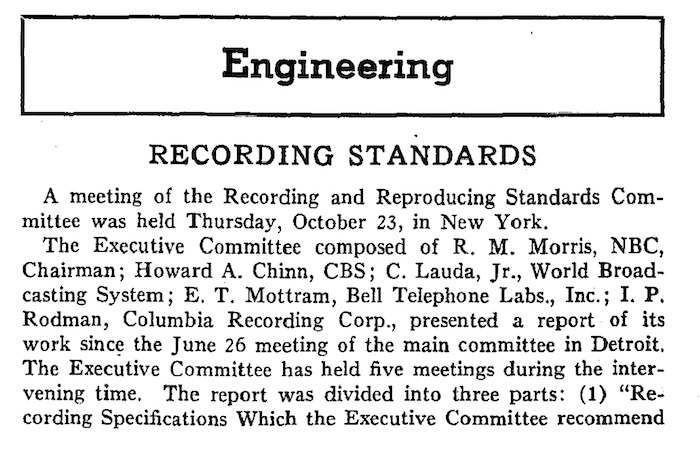
source: “NAB Reports, Vol.9, No.43, October 31, 1941”, p.824
1941年10月23日に行われた「録音・再生規格委員会」第2回会合の模様を伝える記事、の冒頭
A meeting of the Recording and Reproducing Standards Committee was held Thursday, October 23, in New York.
録音・再生規格委員会の(第2回)会合が、10月23日木曜日にニューヨークで開催された。
The Executive Committee composed of R.M. Morris, NBC, Chairman; Howard A. Chinn, CBS; C. Lauda, Jr., World Broadcasting System; E.T. Mottram, Bell Telephone Labs., Inc.; I.P. Rodman, Columbia Recording Corp., presented a report of its work since the June 26 meeting of the main committee in Detroit. The Executive Committe has held five meetings during the interventing time.
NBC の R.M. Morris 氏(委員長)、 CBS の Howard A. Chinn 氏、 World Broadcasting System の C. Lauda, Jr. 氏、 Bell Telephone Labs の E.T. Mottram 氏、 Columbia Recording の I.P. Rodman 氏からなる執行委員会は、1941年6月26日に開催された第1回会合ののち取り組んだ作業のレポートを(参加委員会メンバに)報告した。第1回会合ののち、執行委員会は5回の会合を重ねてきた。
The report was divided into three parts: (1) “Recording Specifications Which the Executive Committee recommend be adopted as Standard”. This contained 15 proposed standards. (2) “Factors Which the Executive Committee Recommends be Referred to Subcommittees for Further Consideration”, and (3) “Factors Regarded by the Executive Committee as not Requiring Standardization at this Time”.
(その結果となる)レポートは、3パートに分かれていた。(1)「標準規格として採用すべし、と執行委員会が勧告する録音規格」(これには15項目の推奨規格が含まれていた)。(2)「分科会において更なる検討を要する、と執行委員会が勧告する要素」、そして (3)「このタイミングで標準化する必要なし、と執行委員会が判断した要素」である。
After much discussion of the Executive Committe’s report, 15 standards were adopted including two on the highly controversial subject of Recording Frequency Characteristics. Separate characteristics were adopted for vertical and lateral transcriptions. Standards were also adopted on the following: Outer Diameter; Center Hole Diameter; Reproducing Center Pin Diameter; Outermost Recording Groove Diameter; Innermost Recording Groove Diameter; Uniformity of Groove Spacing; Stopping Groove; Number of Blank Grooves; Absolute Turntable Speed; Wow Factor; Record Warp; Minimum Label Information; Starting Spiral Grooves per Inch; and Recording Grooves per Inch.
執行委員会のレポートに対して多くの議論が行われたのち、15項目の標準規格が採択された。この中には、大いに論議を呼んだトピックである記録周波数特性の2項目も含まれている。縦振動盤用と横振動盤用に、それぞれ別の記録特性が採択された。その他採択された項目は以下の通りである。ディスクの外径、センターホール径、再生機側のセンターピン径、音溝を記録可能な最外径、音溝を記録可能な最内径、溝間隔の均一性、停止溝、ブランク溝の数、ターンテーブル回転速度、ワウファクター、レコードの反り、レーベルに記載すべき情報、開始溝の溝間隔、そして録音時の溝間隔。
Four subcommittees were appointed to make a further detail study of nine additional items. Subcommittee I, under the chairmanship of I.P. Rodman, Columbia Recording, is to study Recording Groove Contour; Subcommittee II, chairman R.M. Morris, NBC, to study Distortion; Subcommittee III, chairman Howard Chinn, CBS, to study Direction of Recording, Record Life, Glossary of Terms and Symbols, and Concentricity; Subcommittee IV, chairman Dr. S.J. Begun, Brush Development Company, to study Reproducing Systems.
更なる検討を要する9項目については、4つの分科会が設置された。分科会1 (議長: Columbia Recording の I.P Rodman 氏) では、記録溝の形状について調査研究を行う。また分科会2 (議長: NBC の R.M. Morris 氏) では歪について、分科会3 (議長: CBS の Howard Chinn 氏) では記録方向、盤の寿命、用語集や記号集、同心度について、分科会4 (議長: Brush Development の S.J. Begun 氏) では再生システムについて、それぞれ調査研究を行う。
NAB Reports, Vol.9, No.43, October 31, 1941, pp.824-825 (courtesy of James Michael Baxter, University of Maryland College Park)やはりというか、なんというか、10月7日の執行委員会の時とは異なり、この10月23日の委員会では 録音周波数特性の決定に際して議論紛糾があった ように読めます。
It turned out – after all – that this report suggests the standardization of recording frequency characteristic led heated arguments at the Oct. 23 Committee meeting, while it did not happen at the Oct. 7 Executive Committee.
執行委員会メンバは NBC(つまり裏は RCA)と CBS (つまり裏は Columbia)と Columbia Recording が横振動トランスクリプション派、そして Bell Telephone Labs(つまり裏は Western Electric)と World Broadcasting System(Western Electric からライセンスを受けていた)が縦振動トランスクリプション派です。前者では RCA/NBC が2年前に Orthacoustic カーブ策定で一歩リードしほぼ業界標準、後者は Bell Labs / WE のカーブが事実上標準というかそれしかなかった、ということで、両方を標準規格として推奨したことになります。
Executive Committee consisted of the members of the following companies: NBC (thus RCA), CBS (thus Columbia) and Columbia Recording, all used lateral transcriptions, where Orthacoustic curve (that RCA/NBC released in 1939) was quasi-standard; Bell Telephone Labs (thus Western Electric) and World Broadcasting System (licensed from Western Electric) used vertical transcriptions, where only one curve (by Bell/WE) was used. This was why two characteristic were peacefully adopted as recommended standards.
一方、メインの委員会は今や67の企業や個人が参加する組織ですから、執行委員会が提出した案に対し、いろんな異論反論があったのでしょう。どの委員会メンバからどんな意見が出たのか興味津々ですが、詳細な議事録や速記録が残っているのか分かりませんし、見つけられませんでしたので、これ以上追うことはできません。ともあれ、10月23日に参加した参加者全員の投票によって、トランスクリプション盤用録音周波数特性(録音カーブ)が2種類採択されたことになります。
On the other hand, the main Committee consists of variety of members – representing 67 companies and individuals in total. It can be that there were some counterarguments and/or objections against the recommended standards from the Executive Committee. Unfortunately I am not sure if some detailed minutes or shorthand notes exist – at least I could not find any – and I can’t continue deeper study of which member/company claimed what kind of recording characteristic (or why he/she raised an objection to the recommended standard). Anyway, at the main committee on Oct. 23, two recording frequency characteristics (both lateral and vertical) were finally adopted as items of the standards, as a result of votings by all participants.
8.1.10 NAB Reports, Vol.10, No.4, January 23, 1942
録音・再生標準規格について NAB Reports で次に記載が見つかるのは翌年冒頭、太平洋戦争勃発からひと月以上経過した1942年1月23日号です。「WARTIME ENGINEERING CONFERENCE」(戦時下における技術者カンファレンス)という欄に、1942年2月23日〜27日に開催される Broadcast Engineering Conference 1942 で扱われるトピックについて紹介されており、その中で触れられています。
Next appearance of Recording Standards Committee on NAB Reports was found in the January 23, 1942 issue – over a month after the outbreak of Asia-Pacific War. Topics that will be featured at Broadcast Engineering Conference 1942 on Feb. 23-27, 1942 are reported in the “WARTIME ENGINEERING CONFERENCE” section. “Recording Standards” topic is one of them.
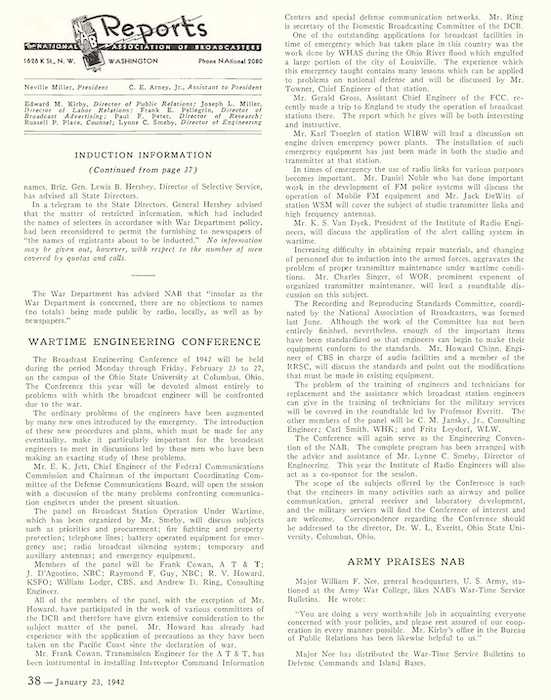
source: “NAB Reports, Vol.10, No.4, Janaury 23, 1942”, p.38
1942年2月に開催予定の「放送技術カンファレンス」において「録音・再生規格委員会」の採択した規格とその技術詳細を紹介する予定である、と報告する記事
The Recording and Reproducing Standards Committee, coordinated by the National Association of Broadcasters, was formed last June. Although the work of the Committee has not been entirely finished, neverthless, enough of the important items have been standardized so that engineers can begin to make their equipment conform to the standards. Mr. Howard Chinn, Engineer of CBS in charge of audio facilities and a member of the RRSC, will discuss the standards and point out the modifications that must be made in existing equipment.
昨年 (1941年) 6月、NAB (全米放送事業者協会) が中心となり「録音・再生規格委員会」が発足した。この委員会の作業はまだ完了していないが、重要な項目については十分に標準化されており、この標準規格に適合するよう各エンジニアが自分の機器に手を入れ始められるようになっている。CBS の音響設備担当エンジニアであり RRSC(録音・再生規格委員会)メンバである Howard Chinn 氏が、この規格について(Broadcast Engineering Conference 1942 にて)説明し、既存の機器に加えなければならない修正点を指摘することになっている。
NAB Reports, Vol.10, No.4, January 23, 1942, p.388.1.11 NAB Reports, Vol.10, No.10, March 6, 1942
さて、オハイオ州立大学で開催された「WARTIME ENGINEERING CONFERENCE」における、RRSC(録音・再生規格委員会)のレポートは、3月6日号に掲載されています。太平洋戦争中のため、今後2ヶ月をかけて残る標準化項目を少しでも多く規格化し、その後は作業が延期されることになる、と記されています。
Then on the March 6 issue of NAB Reports, the results of WARTIME ENGINEERING CONFERENCE are reported, including the topic of RRSC (Recording and Reproducing Standards Committee). It says, because of the wartime, as many of the items as possible would be standardized within two months, then the work would be deferred.
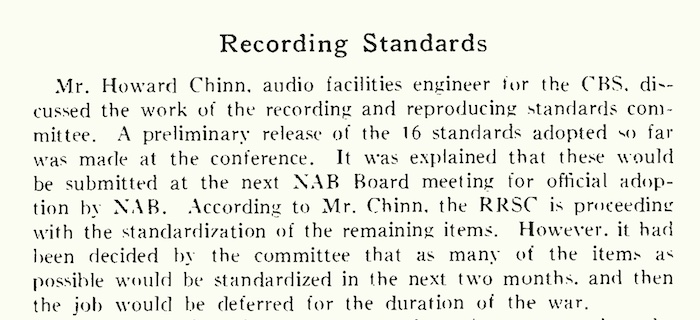
source: “NAB Reports, Vol.10, No.10, March 6, 1942”, p.135
1942年2月に開催された「放送技術カンファレンス」における「録音・再生規格委員会」に関するパートを報告する記事
Mr. Howard Chinn, audio facilities engineer for the CBS, discussed the work of the recording and reproducing standards committee. A preliminary release of the 16 standards adopted so far was made at the conference. It was explained that these would be submitted at the next NAB Board meeting for official adoption by NAB. According to Mr. Chinn, the RRSC is proceeding with the standardization of the remaining items. However, it had been decided by the committee that as many of the items as possible would be standardized in the next two months, and then the job would be deferred for the duration of the war.
CBSの音響設備エンジニアである Howard Chinn 氏は、録音・再生規格委員会の作業について議論を行った。本会議において、これまでに採択された16項目の規格について先行リリースとして発表された。これら16項目については、次回のNAB理事会において正式な採択に向けて提出されると説明が行われた。Chinn 氏によると、RRSC(録音・再生規格委員会)では残りの項目についても標準化作業が進行中であるという。しかし、今後2ヶ月のうちに、少しでも多くの項目の規格を策定したのち、戦時下のため作業を延期することが委員会で決定された。
NAB Reports, Vol.10, No.10, March 6, 1942, p.135この、オハイオ州コロンバスで開催された「第5回放送技術カンファレンス」において、Howard Chinn 氏が1942年2月26日に行った発表の原稿は、The Broadcast Engineers’ Journal (旧 ATE Journal) 1942年3月号に掲載されています。「まだNAB委員会に正式承認されていないが」と前置きした上で、本稿後半で紹介する全16項目の規格の他、標準化に至る経緯や規格委員会のこれまでの作業について説明が行われています。
The paper delivered by Howard Chinn at the Fifth Annual Broadcast Engineering Conference at Columbus, Ohio, February 26, 1942, was soon published on The Broadcast Engineers’ Journal (ex-ATE Journal), March 1942, Vol.9, No.3. Although Mr. Chinn writes in this paper as: “Although NAB has not as yet officially placed its stamp of approval on these standards”, the paper includes all of the sixteen standards that would soon to be officially adopted, as well as the background towward the standardization, past works by the Standards Committee, etc.
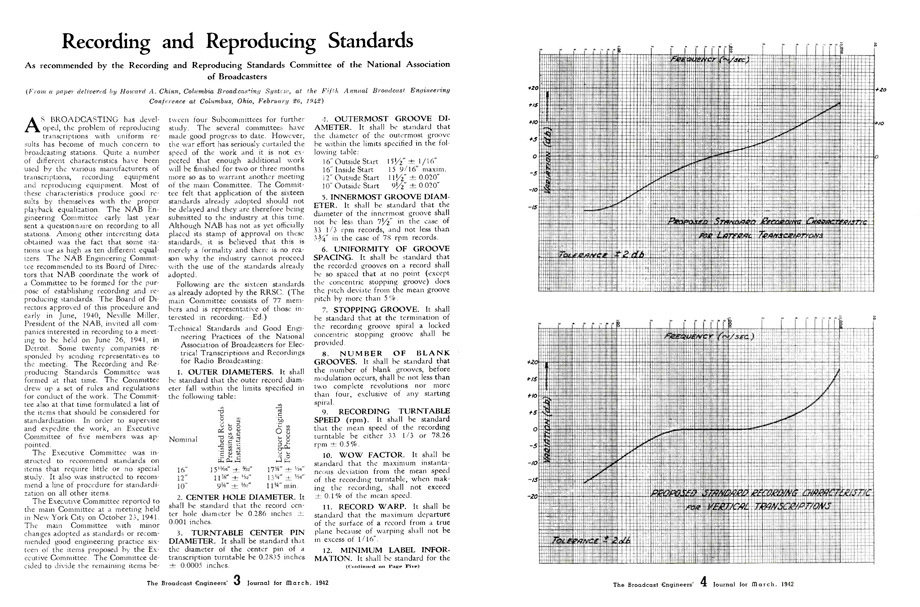
source: “Recording and Reproducing Standards”, Howard A. Chinn, The Broadcast Engineers’ Journal for March, 1942, Vol.9, No.3, pp.3-5.
NAB正式採用前に技術会議及び技術雑誌で公開された、1942 NAB 標準規格の論文
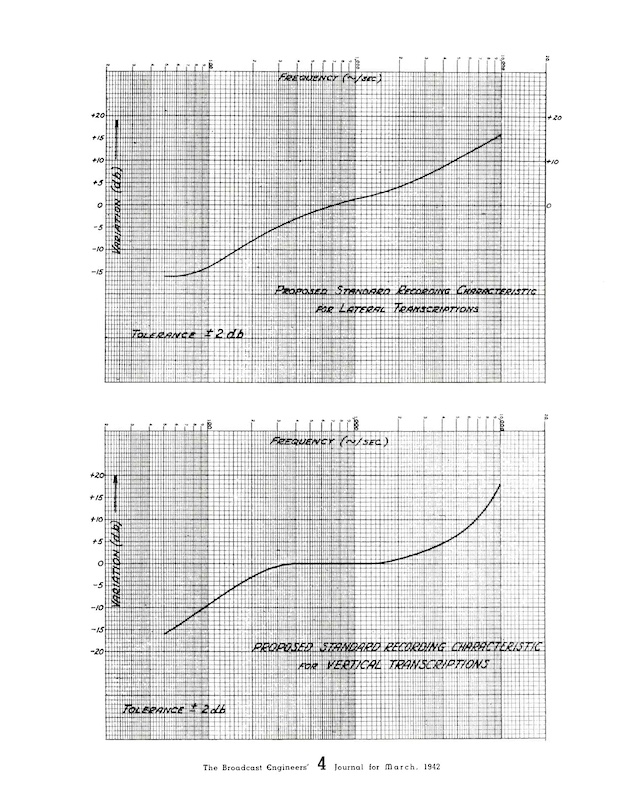
source: “Recording and Reproducing Standards”, Howard A. Chinn, The Broadcast Engineers’ Journal for March, 1942, Vol.9, No.3, p.4.
NAB正式採用前に技術会議及び技術雑誌で公開された、1942 NAB 標準規格の論文に掲載された、縦振動用/横振動用録音周波数特性カーブ
8.1.12 NAB Annual Report, 1942
そして最後に「録音・再生規格委員会」について記載があるのが、1942年5月頃に発行されたと思われる年次報告書です。16項目についてはNAB理事会で正式に採択された、とあります。
NAB Annual Report 1942, probably issued in May 1942, is the last issue that describes the works by the 1941-1942 Recording and Reproducing Standards Committee. It says that sixteen items (adopted by the Committee) were officially adopted by the NAB Board of Directors.
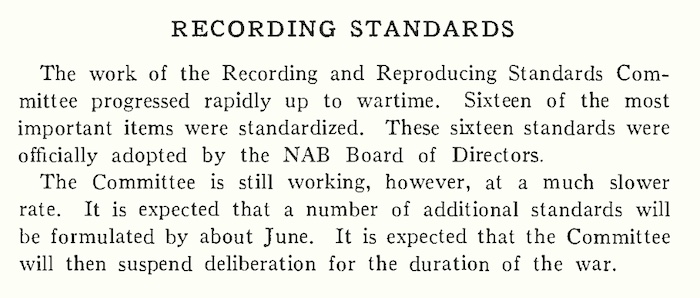
source: “NAB Annual Report, 1942”, p.5
NAB理事会によって正式に採択されたことを伝える記事
The work of the Recording and Reproducing Standards Committee progressed rapidly up to wartime. Sixteen of the most important items were standardized. These sixteen standards were officially adopted by the NAB Board of Directors.
録音・再生規格委員会の作業は、戦争開始までに急速に進展した。最も重要な16項目が標準規格化された。この16の標準規格は、NAB理事会において正式に採択された。
The Committee is still working, however, at a much slower rate. It is expected that a number of additional standards will be formulated by about June. It is expected that the Committee will ben suspend deliberation for the duration of the war.
当委員会は現在も作業継続中であるが、以前よりゆっくりとした進捗である。6月頃までには、さらに追加で標準規格項目がが策定されると見込まれている。また、戦時中は委員会審議が中断されると予想される。
NAB Annual Report, 1942, p.5つまり、1941年5月から1942年5月までの1年間をかけて、まずは暫定版として主要16項目の標準規格が策定されたことになります。
As we have seen in the foregoing parts, the preliminary Standards, consisting of sixteen items, had been adopted after the one-year elaboration from May 1941 to May 1942.
8.1.13 Proceedings of the I.R.E., Vol.30, No.8, August 1942
その、NAB理事会で正式に採択された、最も重要な16項目からなる「録音・再生標準規格」が、IRE (Institude of Radio Engineers, 無線学会) の論文誌に掲載されています。ここでいわゆる 1942 NAB カーブが初めて公式に一般公開された ことになります。
The inital (preliminary) 1942 version of the Recording and Reproducing Standards is documented and featured in the IRE (Institute of Radio Engineers) Journal Proceedings. At this time, the officially adopted 1942 NAB Standards became open to public for the first time.
翌年の NAB Reports 1943年4月30日号 p.191 に「NAB技術部門は、既に多くの録音団体、政府機関、放送局で採用されている録音・再生標準規格の普及奨励を継続的に進めている」とあります。最終的にはさまざまな企業・組織から参加した77名にもなる規格委員会メンバによって採択された標準規格ですから、今まで上でみてきた経緯からも、5月の正式承認直後から、トランスクリプション盤録音・再生の現場で迅速に波及したと考えられます。
In next year, on April 30, 1943 issue of NAB Reports, p.191, it reads “The Engineering Department is constantly encouraging the wide-spread use of the standards which have already been adopted by many recording organizations, govermental agencies and broadcasters”. The 1942 NAB Standards were formulated by the Recording and Reproducing Standards Committee, finally totaling 77 individuals, so the entire story we have seen above strongly suggests that the standard was rapidly applied in the transcription recording/reproducing fields, soon after the NAB adopted it in May 1942.
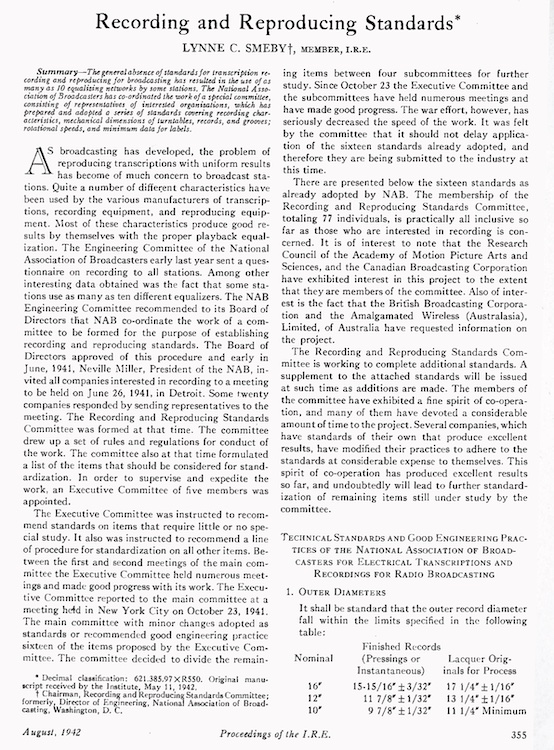
source: “Recording and Reproducing Standards”, Proceedings of the I.R.E., August 1942, Vol.30, No.8, pp.355-356
16項目からなる1942年NAB録音・再生標準規格が最初に公開された論文誌
The Executive Committee was instructed to recommend standards on items that require little or no special study. It also was instructed to recommend a line of procedure for standardization on all other items. Between the first and second meetings of the main committee the Executive Committee held numerous meetings and made good progress with its work. The Executive Committee reported to the main committee at a meeting held in New York City on October 23, 1941. The main committee with minor changes adopted as standards or recommended good engineering practice, sixteen of the items proposed by the Executive Committee. The committee decided to divide the remaining items between four subcommittees for further study. Since October 23 the Executive Committee and the subcommittees have held numerous meetings and have made good progress. The war effort, however, has seriously decreased the speed of the work. It was felt by the committee that it should not delay application of the sixteen standards already adopted, and therefore they are being submitted to the industry at this time.
録音・再生規格委員会の執行委員会は、特別な検討を必要としない項目については、標準規格化を推奨するよう指示された。また、それ以外の項目については、標準規格化に向けた手順を推奨するよう指示された。第1回(6月26日)と第2回(10月23日)の委員会開催の間に、執行委員会は何度も会議の場を設け、順調に作業を進めた。1941年10月23日、ニューヨークで開催された会議において、執行委員会は主委員会に作業結果の報告を行った。主委員会は、執行委員会から提案された項目のうち16項目を、若干の変更を加えて標準規格またはエンジニアリング実践規範として採用した。また、残りの項目については、4つの分科会に分けて検討することとなった。10月23日以降は、執行委員会および各分科会は幾度となく会議を重ね、作業は順調に進んだ。しかし現在、戦争の影響で作業スピードは著しく低下している。そこで、すでに採択された16項目の規格の適用を遅らせるべきでない、という委員会の判断により、このタイミングで業界に提出するものである。
There are presented below the sixteen standards as already adopted by NAB. The membership of the Recording and Reproducing Standards Committee, totaling 77 indivisuals, is practically all inclusive so far as those who are interested in recording is concerned. It is of interest to note that the Research Council of the Academy of Motion Picture Arts and Sciences, and the Canadian Broadcasting Corporation have exhibited interest in this project to the extent that they are members of the committee. Also of interest is the fact that the British Broadcasting Corporation and the Amalgamated Wireless (Australasia), Limited, of Australia have requested information on the project.
以下、本稿では NAB が既に採択した16項目の標準規格を紹介する。録音・再生規格委員会のメンバは現在77名で、録音に関心のある業界メンバを実質的に全て含んでいると言える。興味深いことに、映画芸術科学アカデミー研究評議会やカナダ放送協会も、委員として参加することで、本プロジェクトに関心を示してくれた。同じく興味深いことに、英国放送協会(BBC)およびオーストラリアのアマルガメット・ワイヤレス(オーストラレーシア)社からも、本プロジェクトに関する情報提供の依頼を受けている。
The Recording and Reproducing Standards Committee is working to complete additional standards. A supplement to the attached standards will be issued as such time as additions are made. The members of the committee have exhibited a fine spirit of co-operation, and many of them have devoted a considerable amount of time to the project. Several companies, which have standards of their own that produce excellent results, have modified their practices to adhere to the standards at considerable expense to themselves. This spirit of co-operation has produced excellent results so far, and undoubtedly will lead to further standardization of remaining items still under study by the committee.
録音・再生規格委員会では現在、追加標準規格の完成に向けて作業中である。それら追加標準規格が作成され次第、当規格の補足資料を発行する予定となっている。委員会メンバは素晴らしい協力精神を発揮し、多くのメンバが本プロジェクトに多くの時間を割いてくれた。優れた結果をもたらす独自の規格を既に持っているいくつかの企業は、本標準規格に準拠すべく、かなりの費用を投じて現場での実装を修正してきた。このような協力の精神は、これまでのところ素晴らしい結果を産んでおり、委員会が引き続き作業している残りの項目についても標準規格化をさらに進めることになるのは間違いないであろう。
Recording and Reproducing Standards, by Lynne C. Smeby, Proceeding of the I.R.E., Vol.30, No.8, August 1942, pp.355-356.この最後のパラグラフから、各企業の思惑やこだわりを超えて、業界一体となって録音再生特性の標準化作業が行われたことが読み取れます。
This last paragraph surely shows that the standardization was made with all the companies and individuals working together, without enforcing his/their particular preferences and schemes.
ここで思うのは、12年後、民生用レコード向けの録音再生特性である RIAA においては、どのように標準規格化が行われたのだろうか、どんな雰囲気だったのか、ということです。それを探求するのは、あとの楽しみにとっておきましょう。
After reading these lines, I am wondering how the RIAA Recording and Reproducing Standards had been discussed and designed, in what kind of atompsphere. We will wait and see afterwards in the forthcoming parts of my entire article.
8.2 Recording and Reproducing Standards (1942 NAB)
では最後に、その 1942年NAB標準規格そのもの をみていきましょう。項目自体は意外とアッサリとしている印象を持たれるかもしれませんが、上記でみてきた経緯や、NAB Reports 誌上には載らなかった様々な議論があったであろうと考えると、各社の思惑がある中、よくぞこのような簡潔な標準規格化にこぎつけたものだ、と感慨もひとしおです。そしてなにより、ディスクレコードに関わる業界における、初めての標準規格の誕生です。
Finally, we are going to take a look at the sixteen items on the 1942 NAB Standards. You might think every item is fairly simple. However, as we have seen the background history of the formulation of these standards (and many possible stories that were undocumented on the NAB Reports), probably overcoming several difficulties among technical/political considerations by all companies, I am deeply moved somehow. Furthermore, above of all, this is the first Standard ever in the industries that deals with disc records.
1942年NAB標準規格の正式名称は「Technical Standards and Good Engineering Practices of The National Association of Broadcasters for Electrical Transcriptions and Recordings for Radio Broadcasting」、すなわち「NAB策定、放送局用トランスクリプション盤用、およびラジオ放送における(即時)録音用の、技術的標準規格およびエンジニアリング実践規範」とでもなりますでしょうか。上述の通り、16項目から構成されています。
The official title of the 1942 NAB Standards is: “Technical Standards and Good Engineering Practices of The National Association of Broadcasters for Electrical Transcriptions and Recordings for Radio Broadcasting”. It consists of sixteen items.
例えば 第1項目は、ディスク盤の外径寸法 に関するものです。プレスされたトランスクリプション盤とアセテート盤の寸法、そしてプレス原盤の寸法について、標準サイズと誤差の許容範囲が示されています。これらは、ラッカー盤(アセテート盤)製造メーカの機材、および、プレス工場の機材が関係することになります。
For example, the first item defines the outer diameter of disc records (pressed records, instantaneous discs, and lacquer masters for process). This item is related to manufacturing lacquer discs both for instantaneous recording and press masters, as well as equipment at pressing plants.
1. OUTER DIAMETERS
- It shall be standard that the outer record diameter fall within the limits specified in the following table:
1. ディスクの外径寸法
- ディスクの外径寸法は、以下の表で規定される上下限の間に収まるものとし、これを標準規格とする。
 Recording and Reproducing Standards, by Lynne C. Smeby, Proceeding of the I.R.E., Vol.30, No.8, August 1942, pp.355-356.
Recording and Reproducing Standards, by Lynne C. Smeby, Proceeding of the I.R.E., Vol.30, No.8, August 1942, pp.355-356.第2項目 は「センターホール径の寸法」、第3項目 は「ターンテーブル側のセンターピン径の寸法」です。前者は第1項目と同じくラッカー盤製造メーカとプレス工場の機材が関係します。
The second item defines the “center hole diameter” of disc records, while the third item defines the “turntable center pin diameters”. The former is related to manufacturing lacquer discs as well as equipment at pressing plants.
2. CENTER HOLE DIAMETER
- It shall be standard that the record center hole diameter be 0.286″ ± 0.001″.
2. センターホール径の寸法
- レコードのセンターホールの径は 0.286″ ± 0.001″ (7.2644mm ± 0.0254mm) とし、これを標準規格とする。
3. TURNTABLE CENTER PIN DIAMETER
- It shall be standard that the diameter of the center pin of a transcription turntable be 0.2835″ ± 0.0005″.
3. ターンテーブルのセンターピン径の寸法
- トランスクリプション盤用ターンテーブルレコードのセンターピンの径は 0.2835″ ± 0.0005″ (7.2009mm ± 0.0127mm) とし、これを標準規格とする。
第4項目「音溝を記録可能な最外径」、そして 第5項目「音溝を記録可能な最内径」 は、カッティングレースの仕様と操作手順、そして再生機側の仕様に関係があります。
The fourth item “outermost groove diameter” and the fifth item “innermost groove diameter” are related to the specification and operating procedure of cutting lathes, as well as the specification of reproducing turntables.
4. OUTERMOST GROOVE DIAMETER
- It shall be standard that the diameter of the outermost groove be within the limits specified in the following table:
4. 音溝を記録可能な最外径
- 記録される音溝の最外周の径は、以下の表で規定される上限内に収まることとし、これを標準規格とする。

5. INNERMOST GROOVE DIAMETER
- It shall be standard that the diameter of the innermost groove shall be not less than 7 1/2″ in the case of 33 1/3 revolution-per-minute records and not less than 3 3/4″ in the case of 78-revolution-per-minute records.
4. 音溝を記録可能な最内径
- 記録される音溝の最内周の径は、33 1/3回転のレコードの場合は 7 1/2″ (19.05cm) 以下にならず、78回転のレコードの場合は 3 3/4″ (9.525cm) 以下にならないようすることとし、これを標準規格とする。
第6項目「溝間隔の均一性」 は、カッティングレースのピッチの正確性に関係があります。
The sixth item “uniformity of groove spacing” is related to the pitch accuracy of the cutting lathes.
6. UNIFORMITY OF GROOVE SPACING
- It shall be standard that the recorded grooves on a record shall be so spaced that at no point (except the concentric stopping groove) does the pitch deviate from the mean groove pitch by more than 5 per cent.
6. 溝間隔の均一性
- レコードの記録溝は、同心円上の停止溝を除き、全体の平均溝ピッチから5%以上ずれないような間隔とし、これを標準規格とする。
第7項目「停止溝」 は、市販レコードでは(オートチェンジャーなどを念頭に)さまざまなパターンがあった最内周の停止溝について、トランスクリプション盤では「同心円状」と最もオーソドックスなパターンを規格化しています。
The seventh item “stopping groove” defines “a locked concentric stopping groove”, while on the consumer 78 rpm records several variations of the stopping groove existed (some probably relating to the specification of autochanger record players at that time).
7. STOPPING GROOVE
- It shall be standard that at the termination of the recording groove spiral a locked concentric stopping groove shall be provided.
7. 停止溝
- 螺旋状に記録された音溝の(最内周の)終端には、同心円上の停止溝が設けられているものとし、これを標準規格とする。
第8項目「ブランク溝の数」 は、最外周の導入溝の内側、かつ音の記録が開始する前の無音状態の長さを周回数で規定しています。カッティング時の手順や操作系に関係がある項目でしょう。
The eighth item “number of blank grooves” defines the area of “blank grooves” by numbers of complete revolutions. This is related to the procedure and operating system while cuttings are made.
8. NUMBER OF BLANK GROOVES
- It shall be standard that the number of blank grooves before modulation occurs shall be not less than two complete revolutions nor more than four, exclusive of any starting spiral.
8. ブランク溝の数
- 音が記録される前のブランク溝については、2回転以上4回転以下であることとし、これを標準規格とする。
第9項目「録音ターンテーブルの回転速度」 は、1930年代からずっと使われていたものであるものの、33 1/3回転および 78.26回転を厳密に規定しています。カッティングレースの仕様、そして(間接的には)トランスクリプションターンテーブルの仕様に関係します。
The ninth item “recording turntable speed (revolutions per minute)” strictly defines two standard speeds – 33 1/3 rpm and 78.26 rpm – they have already been common since the early 1930s, though. These are related to the specification of cutting lathes, and (indirectly) to the specification of transcription reproducing turntables.
9. RECORDING TURNTABLE SPEED (Revolutions per Minute)
- It shall be standard that the mean speed of the recording turntable be either 33 1/3 or 78.26 revolutions per minute ± 0.5 per cent.
9. 録音ターンテーブルの回転速度 (rpm)
- 録音ターンテーブルの平均回転数は、 33 1/3回転、または 78.26回転で、かつ ±0.5% とし、これを標準規格とする。
第10項目「ワウファクター」 は、カッティングレース側の仕様に関係するもので、第9項目で規定された2通りの回転数から最大偏差±0.1%であること、となっています。
The tenth item “wow factor” is related to the specification of cutting lathes.
10. WOW FACTOR
- It shall be standard that the maximum instantaneous deviation from the mean speed of the recording turntable, when making the recording, shall not exceed ±0.1 per cent of the mean speed.
10. ワウファクター
- 録音を行う際のカッティングレースの回転速度の平均からの最大瞬間偏差は、平均回転速度の±0.1%を超えてはならないものとし、これを標準規格とする。
第11項目「レコードの反り」 では、許容できる反りの範囲を規定しています。ラッカー盤製造メーカの工作精度に関係しますし、許容範囲内の反りであれば記録・再生できるよう、録音・再生装置側の仕様にも関係します。
The eleventh item “record warp” strictly defines maximum permissible amount of warp. This is related to machining accuracy of manufacturing lacquer discs, as well as recording/reproducing turntables so that they can reproduce such warped discs safely.
11. RECORD WARP
- It shall be standard that the maximum departure of the surface of a record from a true plane because of warping shall not be in excess of 1/16″.
11. レコードの反り
- 反りによる、真っ平な盤面からの最大偏差は、1/16インチ (1.5875mm) を超えてはならないものとし、これを標準規格とする。
第12項目「最低限記載すべきレーベル情報」 は、レーベルに最低でも書かれていなければならない項目を規定しています。これは、トランスクリプション盤利用者の便に配慮した規定でしょう。
The twelfth item “minimum label information” shows consideration for transcription disc users.
12. MINIMUM LABEL INFORMATION
- It shall be standard for the label of a recording to contain at least the following technical information:
- Type of recording – vertical or lateral
- Speed – 78.26 or 33 1/3
- Direction of feed (start) – outside-in or inside-out
- Recording frequency characteristic
12. 最低限記載すべきレーベル情報
- レコードレーベルには、最低でも以下の技術情報が記載されていることとし、これを標準規格とする。
- 録音タイプ: 縦振動か、横振動か
- 速度: 78.26回転か、33 1/3回転か
- 再生開始方向: アウトサイドイン(外周スタート)か、インサイドアウト(内周スタート)か
- 録音記録特性
第15項目「開始溝の溝間隔」 は、最外周(内周スタートの場合は最内周)など導入溝でのピッチ (gpi, grooves per inch) を定めたものです。これは標準規格ではなく、エンジニアリング実践規範として記されています。つまり、これを満たさない盤がすなわち標準規格に逸脱している、というわけではない、ということです。
The fifteenth item “starting spiral grooves per inch” defines the g.p.i. of the starting spiral. This is not included as the standard, but as good engineering practice.
15. STARTING SPIRAL GROOVES PER INCH
- It shall be good engineering practice in recordings having a starting spiral to use a rate of eight grooves per inch for the spiral. (Tolerance ±2 grooves per inch.)
15. 開始溝の溝間隔 (gpi)
- ディスク録音においては導入溝を用い、その導入溝の溝間隔 (gpi) は1インチあたり8本の密度、すなわち 8gpi(許容誤差 ±2 gpi)とする。これをエンジニアリング実践規範として定める。
第16項目「録音時の溝間隔」 は、音記録溝のピッチ (gpi) を定めたもので、これもエンジニアリング実践規範として記されています。
The sixteenth item “recording grooves per inch” defines the g.p.i. of the main part of the sound groove, also as good engineering practice.
16. RECORDING GROOVES PER INCH
- It shall be good engineering practice use numbers of grooves per inch in recording as follows: 96, 104, 112, 120, 128, 136, etc., in increments of eight. (Tolerance ±2 grooves per inch.)
16. 録音時の溝間隔 (gpi)
- ディスク録音における溝間隔 (gpi) は以下のように定める: 96, 104, 112, 120, 128, 136, など8ずつ増やした数のいずれか(許容誤差 ±2 gpi)とする。これをエンジニアリング実践規範として定める。
順番が前後しましたが、第13項目「縦振動記録における周波数特性」 が、縦振動トランスクリプション盤用録音特性、第14項目「横振動記録における周波数特性」 が、横振動トランスクリプション盤用録音特性の定義となっています。
I have got rather mixed up, but the most remarkable standard items, the thirteenth item “Frequency Characteristic for Vertical Recording” as well as the fourteenth item “Frequency Characteristic for Lateral Recording” are specified like these:
13. FREQUENCY CHARACTERISTIC FOR VERTICAL RECORDING
- It shall be standard that the recorded frequency characteristic on vertically recorded records be as shown in Fig. 1.
13. 縦振動記録における周波数特性
- 縦振動記録されたレコードの録音周波数特性は、図1に示す通りとし、これを標準規格とする。
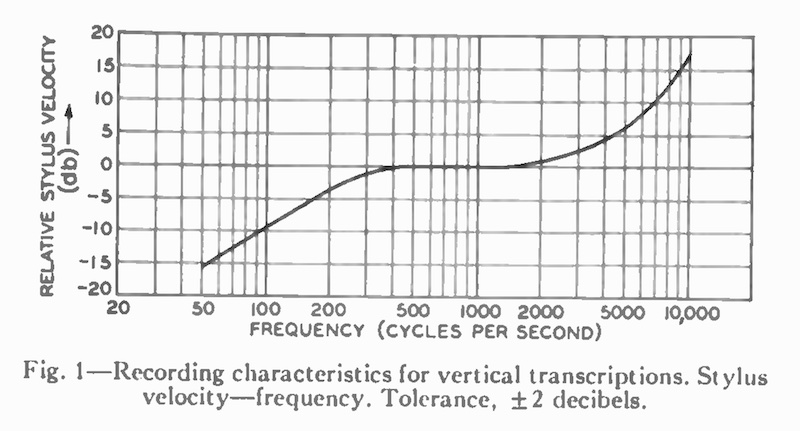
source: “Recording and Reproducing Standards”, Proceedings of the I.R.E., August 1942, Vol.30, No.8, pp.355-356
1942年NAB録音・再生標準規格の第13項目として定義された、縦振動用録音周波数特性グラフ
14. FREQUENCY CHARACTERISTIC FOR LATERAL RECORDING
- It shall be standard that the recorded frequency characteristic on laterally recorded records be as shown in Fig. 2.
14. 横振動記録における周波数特性
- 横振動記録されたレコードの録音周波数特性は、図2に示す通りとし、これを標準規格とする。
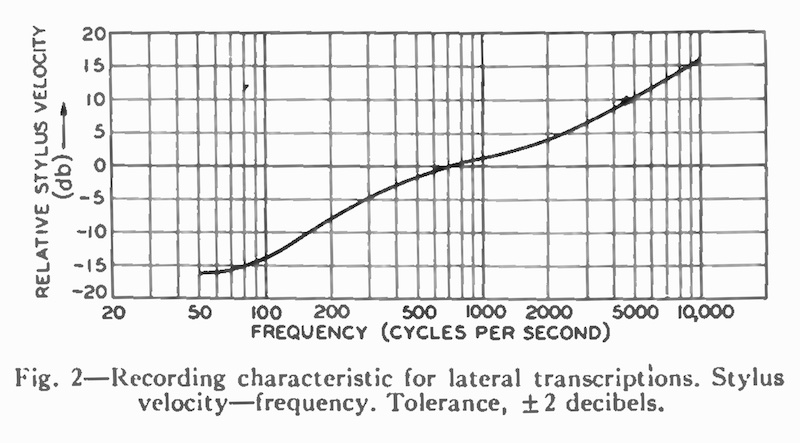
source: “Recording and Reproducing Standards”, Proceedings of the I.R.E., August 1942, Vol.30, No.8, pp.355-356
1942年NAB録音・再生標準規格の第13項目として定義された、横振動用録音周波数特性グラフ
で、結局、縦振動盤の録音特性として、本稿 Pt.4 セクション 4.4 で紹介した、ベル研/WE が使用してきた特性がそのまま採用され、横振動盤の録音特性として、本稿 Pt.5 セクション 5.2.1 で紹介した、RCA/NBC の Orthacoustic カーブがそのまま採用された格好になります。しかも「誤差 ±2dB」という緩い規格であることも全く同じです。
After all, the Bell/WE’s recording characteristic for vertical transcription (as shown in the Part 4 Section 4.4) and the RCA/NBC’s Orthacoustic curve for lateral transcription (as shown in the Part 5 Section 5.2.1) was accepted as standrads. “Torelance ±2dB” is still there.
そして、「誤差±2dB」というのは、1942年当時各スタジオやレーベルで使われていた録音用イコライザの回路構成や実現方法が各社まちまちだった(LRC/RC/LR の別、またはパッシブ/アクティブの別)ため、新たに費用を捻出して録音用イコライザを調達するコストをかけることなく、既存のイコライザに修正を施してグラフで示された特性に近づけるために必要な措置だったのでは、と考えています。
As for the “Tolerance ±2dB”, I guess it was a necessary measure for all studios and labels using recording equalizers with different circuit structure – LRC or RC or LR, passive or active, etc. – so that they didn’t have to raise the cost to install brand-new equalizer that follow the new Standard recording curve: with this “±2dB” tolerance, some modifications could be made in existing equipment.

Western Electric Vertical/Lateral Recording Characteristics (1942 NAB), drawn on Nov. 23, 1942
Western Electric 社の縦振動/横振動用録音カーブ (1942 NAB vertical/lateral) をプロットした貴重なグラフ (Nicholas Bergh さん提供)
Western Electric 社においては、録音/再生イコライザ共に LRC 回路で構成されていた、とは Nicholas Bergh さんの弁
Plotted graph of Western Electric’s lateral/vertical recording characteristic in 1942
photo courtesy of Nicholas Bergh.
Nicholas-san says Western Electric at the time used LRC equalizers both for recording and reproducing.
また、この1942年時点においては、どのような回路やパラメータでこの録音特性を実現するか、についての記載は一切なく、周波数特性カーブのグラフが掲載されるに留まっています。このことからも、録音用イコライザの実現方法や回路構成が各社まちまちだったと類推されます。ほぼ同等の回路構成(たとえばRC回路)であれば、抵抗やコンデンサのパラメータ(あるいは時定数)の指定も可能なはずですから。
Also, as for this 1942 Standards, circuit structure nor parameters (like time constants) was NOT specified – only the frequency response curves were included in the Standards. This also suggests that every studio had its own recording equalizer with its own circuit structure and parameters. If there was one variation of circuit structure among all studios, the Standards would possibly specify parameters for resistors and condensors (sometimes as “time constants”).
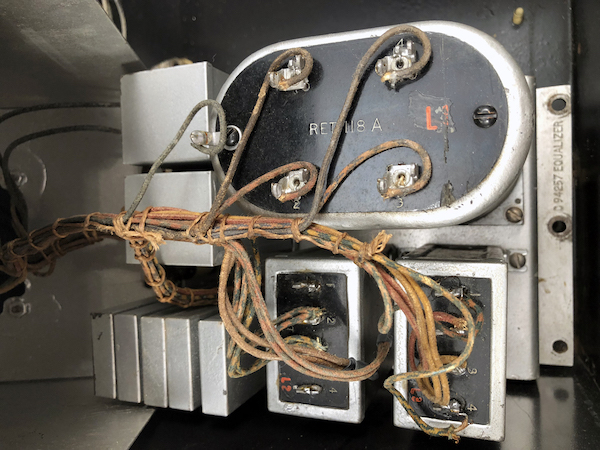
Very rare genuine WE LRC playback compensator (equalizer) from early 1930s for WE vertical transcription disc
本稿 Pt.4 セクション 4.4.1 でも紹介した、非常に珍しく貴重な、1930年代前半製 Western Electric 社製、縦振動記録トランスクリプション盤再生用LRCフォノイコのホンモノ (Nicholas Bergh さん提供)
Photo courtesy of Nicholas Bergh.
さらにもう一点気づいたでしょうか。「録音・再生標準規格」という名前なのに、この1942年版の時点では、再生側に関する規格が一切含まれていません。これは、戦時下で規格策定作業が遅れ(多くのエンジニアが軍事向けの研究や技術開発に追われていたのでしょう)、先送りにしていたからです。再生側に関する規格は、1949年の NAB 規格で策定されることになります(本稿 Pt.10 を参照)。
Yet another point you already noticed? Although it is “Recording and Reproducing Standards”, this 1942 Standards does not contain Reproducing Standards at all. It was because the work had been delayed during the wartime (many engineers and researchers went so busy researching and developing for the wartime technology) and was postponed. Items of the standards relating to reproducing equipment would eventually included and adopted as 1949 NAB Standards (see: Pt.10 of my article).
8.3 How the 1942 NAB Curve was accomplished / 1942 NAB カーブの当時の実現方法
実質 Bell Labs / WE のカーブ1種類しかなかった縦振動トランスクリプションと違い、横振動トランスクリプション用には RCA/NBC の Orthacoustic カーブが NAB の横振動標準規格として採用されたわけですが、当時のエンジニアはこのカーブにどうやって準拠していたのでしょうか。そのヒントを、当時発表された技術論文、および RCA などが放送局向けに販売していた録音システムやトランスクリプション盤用ターンテーブルの資料に見ることができます。
After we read all the story of the NAB Standards formulation, now we know RCA/NBC Orthacoustic curve was adopted as recording frequency characteristic for lateral-cut transcriptions (on the other hand, there was virtually one recording/reproducing curve for vertical transcriptions, developed by Bell Labs/WE). So I am curious how each engineer (at the time) tried to cope with obtaining this recording characteristic. Some hints of it can be found in the technical papers, as well as catalogs of recording/reproducing equipment from RCA and other manufacturers.
8.3.1 RCA Review, Vol.6, No.4, April 1942
RCA が季刊で発行していた技術論文誌 “RCA Review” の1942年4月号において、NAB録音カーブを実現するための技術詳細が解説されています。タイトルは “A Discussion of Several Factors Contributing to Good Recording”(優れた録音に貢献するいくつかの要因についての議論)です。
Apr. 1942 issue of the quarterly journal “RCA Review” (published by RCA Institues Technical Press) contains the paper describing some technical details when accomplishing the soon-to-be-standardized 1942 NAB Recording Characteristic. The paper’s title is “A Discussion of Several Factors Contributing to Good Recording”.
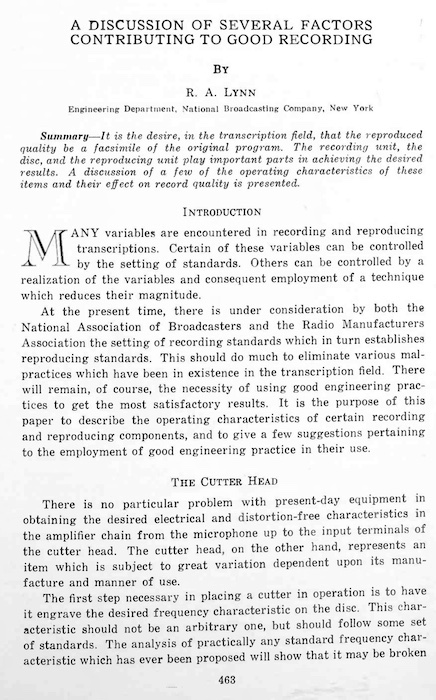
source: “RCA Review, Vol.6, No.4, April 1942”, pp.463-472
NAB標準規格正式策定を目前に控えた時期に発表された、録音における技術プラクティスを解説した論文
著者は NBC の技術部門に所属する R.A. Lynn 氏です。この方は、1941年8月20日に開催された NAB 録音・再生規格委員会の執行委員会にゲスト参加されていました(本稿セクション8.1.4 参照)。
The author of the paper is R.A. Lynn of Engineering Department, NBC. Mr. Lynn was a guest attender at the NAB Recording and Reproducing Executive Committee held on August 20, 1941 (see: Section 8.1.4 of this article).
この論文が掲載された1942年4月というのは、NAB規格が最終策定される直前です。しかもこの論文は、1941年10月24日〜25日にニューヨークのペンシルバニアホテルで開催された、アメリカ音響学会第26回年次総会で行われた Lynn 氏本人による口頭発表を元にしたものです。
April 1942, when the journal was published, was just a few months before the NAB Standards being officially adopted. Also, this paper by Mr. Lynn is based on the oral presentation at ASA (Acoustical Society of America) 26th Annual Meeting, held on Oct. 24-25, 1941, at the Pennsylvania Hotel, New York City.
そう、本稿セクション8.1.3 や 本稿セクション8.1.8 でみたように、録音特性策定に際して議論紛糾があった、10月23日のNAB録音・再生規格委員会第2回会合、その翌日から行われた会議で発表された内容をベースにしています。開催場所も同じくニューヨークのペンシルバニアホテルです。
Yes, the ASA Annual Meeting was held at the same venue as (and on the next day of) the NAB Recording and Reproducing Standards Committee’s second meeting (where there was a controversy and discussion about recording frequency characteristic) on Oct. 23, 1941. This paper is based on the presentation.
来るべき標準規格正式策定を目前に控え、国内の録音エンジニアに向けて、技術的側面から解説する論文である、と言えるでしょう。
So this paper was authored aiming to describe the soon-to-come Recording Standard, from a technological point of view.
この論文では、録音・再生標準規格のうち、機械的側面ではなく電気的側面(録音周波数特性)に絞って解説が行われています。ポイントは5点です。
- ディスクに溝を刻むカッターヘッド自体の基本的な録音周波数特性の実現方法について
- 追加で施されるプリエンファシスによる周波数特性の実現方法について
- 録音用カッター針について
- ラッカー原盤について
- 再生機器側の注意点について
This paper describes the overview of disc recording and suggested standards, especially on electrical features (not mechanical features) of recordings. Five important topics are discussed.
- frequency response of cutterheads themselves and how to apply the correction for the ideal response;
- application of pre-emphasis and how-tos;
- recording stylus;
- lacquer discs;
- and notes on reproducers.
まず カッターヘッドの特性 について。この論文が書かれ、またNAB標準規格が正式決定した1942年においては、横振動記録レコードの世界において、フラットな記録特性を持つフィードバックカッターはまだ存在していませんでした(縦振動用には、本稿 Pt.4 セクション 4.4.2 でみたように、1938年から存在していました)。そのため、従来の Bell Labs / WE / RCA などの伝統に則り、カッターヘッド自体の記録周波数特性は「ターンオーバー周波数以下は定振幅、それより上は定速度」が標準で、500Hz が標準的なターンオーバー周波数でした。
Firstly, the frequency response of cutterheads. In the year 1942, when this paper was authored, and when the NAB Standards were officially adopted, there was not yet a recording cutterhead what has “flat” recording frequency characteristic for lateral-cut recordings (on the other hand, “motional feedback” cutterheads for vertical-cut recording already existed from 1938, as we’ve seen in Section 4.4.2 of my particle Pt.4). So, based on the tradition of Bell Labs / WE / RCA etc. of disc recordings, all cutterheads had the frequency response of “constant amplitude below the turnover frequency; constant velocity above the turnover frequency”.
しかし、さまざまな録音現場で使われているカッターヘッドの特性はまちまちで、また計測して補正回路で微調整する習慣もあまり徹底されていなかったようです(実はこれが、当時のレコードで、記録カーブが盤ごとにバラバラだった主原因ではないでしょうか?)。そこで、本論文では、カッターヘッドでテスト記録したものを Buchmann-Meyer の「光帯法」で計測を行い、補正回路を修正することで、1942 NAB カーブ用にカッターヘッド特性を調整する方法が解説されています。
However, many cutterheads used at various recording studios and venues had different frequency response; and not all the recording engineers conducted the engineering practice, of calculating the frequency response and preparing compensating circuit for the desired response (… and I guess this was one of the reasons why every record at that time did not have uniform characteristic among labels, recording sessions, etc.). So in this paper, the method of calibrating the response by Buchmann-Meyer’s “christmas tree pattern”, as well as the use of corrective electrical networks, is demonstrated, in order to accomplish the frequency response that is required to follow the 1942 NAB recording characteristic.
This electrical correction can be made anywhere in the channel equipment, providing it is always associated with a particular cutter. Under normal circumstances, all cutter heads of a given manufacture require similar compensators for the basic correction of the crossover point. However, minor irregularities in the form of high- frequency peaks are sometimes encountered which are not the same for all heads. Such irregularities can be corrected in the compensator. It is for this reason that it is advisable to avoid the use of a compensator with any cutter head other than that for which its circuit elements were adjusted.
ここで述べた電気的な補正法は、特定のカッターと関連づけている限りにおいては、録音チャンネルのどこで行っても構わない。通常は、あるメーカのカッターヘッドにおいては、クロスオーバー周波数の補正のために、ほぼ同等の補正回路を使うことになる。しかし、同じメーカ製であっても個体差があり、特に高域のピークの微妙な差となって現れることがある。このような個体差も補正回路で修正可能である。そしてこれが、あるカッターヘッドに対して回路を微調整した補正回路を、他のカッターヘッドにそのまま使用するべきではない、というアドバイスの理由である。
A Discussion of Several Factors Contributing to Good Recording, RCA Review, Vol.6, No.4, April 1942, pp.463-472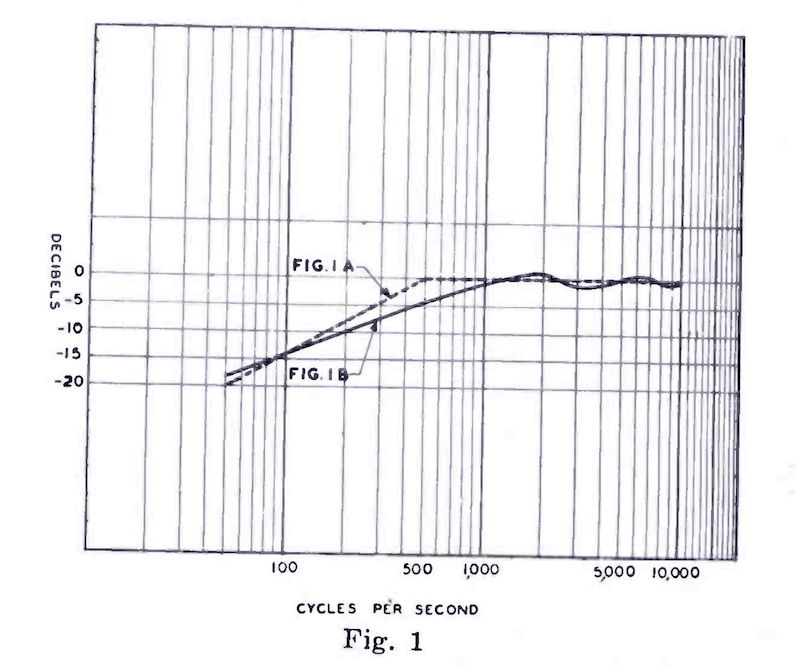
source: “RCA Review, Vol.6, No.4, April 1942”, pp.463-472
カッターヘッドの理想的記録周波数特性(1A、点線)と、当時の某カッターヘッドの特性(1B、実線)の違い。ターンオーバー周波数が 1,000Hz 近くになり、5dB スロープになっている 1B を、ターンオーバー周波数 500Hz かつ 6dB スロープという理想の 1A に近づけるべく、計測して補正回路を使うべし、と解説が行われている。
FIG 1A: the ideal characteristic
FIG 1B: the characteristic of a particular “present-day” lateral recording head for transcription service.
1B’s crossover frequency is not well defined – approximately 1,000Hz, and below the crossover frequency the sope is 5dB/octave, instead of the ideal 6dB/octave slope
“It is necessary, therefore, to resort to compensation.”
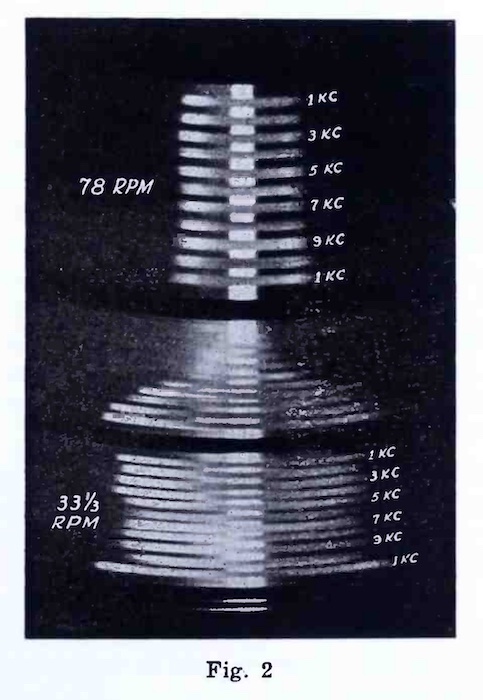
source: “RCA Review, Vol.6, No.4, April 1942”, pp.463-472
テストトーンを記録したレコードに光をあててパターンを見ることで記録特性を計測する Buchmann-Meyer 光帯法の一例
もうひとつ非常に重要な言及は、プリエンファシスの実現方法 に関する箇所です。
Another important mention is the possible implementation of the pre-emphasis.
After the basic recording characteristic is determined, it is then relatively easy to apply the particular pre-emphasis curve required by the standards.
基本的な記録特性(=カッターヘッドの理想的な記録特性)が決まれば、規格で要求される特定のプリエンファシスカーブは比較的容易に適用できる。
Figure 3 shows a proposed lateral-recording characteristic. It follows basically the construction outlined in the foregoing discussion. There is one difference however ; that is, a compromise has been made to accommodate simplified compensator design, especially for the playback circuit. It is noticed that no attempt has been made to preserve the sharp corner at the crossover frequency of 500 cps. The tolerance of ±2 db permits the use of several frequency characteristics that are in use today. These represent standards for different organizations which account for a very large percentage of lateral recordings.
図3は、来たる規格で提唱されている横振動盤向けの録音周波数特性である。基本的には先述してきたような特性を持っているが、1点だけ違うのは、特に再生機器側のイコライザの設計を簡略化するために、妥協がなされていることである。(カッターヘッド自体の記録特性とは異なり)500Hzのクロスオーバー周波数での鋭利な角(かど)はここではみられない。また、±2dBの許容誤差により、こんにち使われているさまざまな録音周波数特性を引き続き使用できる配慮がなされており、流通する横振動盤の大多数を占める組織の標準的な規格となっている。
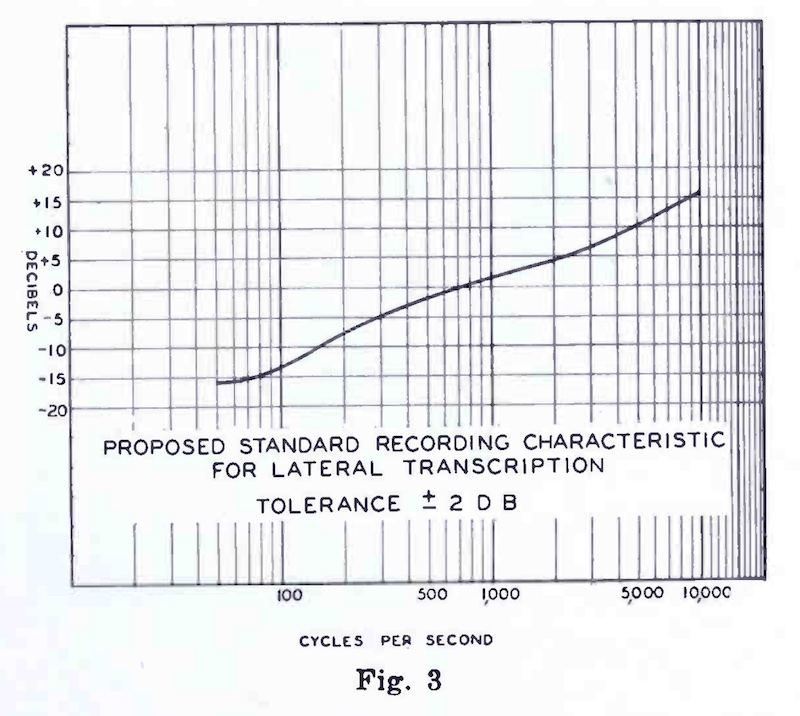
The tolerance of ±2 db appears, at first glance, to be excessively liberal, but it must be realized that this is the final recorded characteristic and, consequently, must absorb the various irregularities in the entire recording channel. The particular pre- emphasis as shown in this case is a 100 -microsecond curve for the treble section. The curve is essentially constant amplitude below 500 cps and in addition there is a slight amount of pre- emphasis below 100 cps.
この±2dBという許容誤差は、一見自由すぎるように見えるが、図3の特性グラフはあくまで最終的に記録される特性であり、録音チャンネル全体におけるさまざまな要因を吸収しなければならないことに留意されたし。高域においては100μsのカーブが、高域プリエンファシスとして使われている。また、500Hz 以下では基本的に定振幅特性(6dB/オクターブのスロープ)であるが、100Hz 以下ではわずかなプリエンファシスが適用されている。
The pre-emphasis curve just mentioned is normally obtained from an electrical circuit consisting of L and R in series, said components having a time constant of 100 microseconds. The formula is L/R = 0.0001, where L is expressed in henries and R is expressed in ohms.
このプリエンファシスカーブは、コイル (L) と抵抗 (R) を直列につないだ LR 電気回路によって実現可能であり、時定数は 100μs である。これを表す式は L/R = 0.0001 で、L がヘンリー、R はオームを単位とする。
A Discussion of Several Factors Contributing to Good Recording, RCA Review, Vol.6, No.4, April 1942, pp.463-472本稿 Pt.5 セクション 5.2.2 でみてきたように、1939年当時の RCA / NBC は、Orthacoustic カーブを LRC 回路で録音・再生していたことが特許申請書類から伺える一方、同年の ATE Journal 上の記事では RC 回路による補正方法が解説されていました。さらに、今みている RCA Journal 上においては、LR 回路によるプリエンファシスを解説しています。このように、当時は目的の録音・再生特性を達成する回路構成がエンジニアごとにまちまちであったり、回路設計自体が試行錯誤の最中であったからこそ、標準規格に時定数など厳密なパラメータが含まれておらず、かつ許容誤差±2dBというゆるい規格だったということになります。
As we have seen on the Part 5 Section 5.2.2 of my article, RCA / NBC in 1939 used the LRC circuit for Orthacoustic recording and reproduction, according to RCA’s patent document; on the other hand, ATE Journal’s technical article described RC circuit networks for recording and reproduction; and this time on RCA Journal, LC network is used for pre-emphasis of the NAB curve (= Orthacoustic curve). In this way, many trials-and-errors was going on to build equalizing/compensating networks, and each engineer was trying to implement his/her own circuits, that means there was no unified electrical circuit design at that time. This would be the main reason of the lack of time constants in the 1942 NAB Standards documentation, and the inclusion of the tolerance of ±2dB.
その他、カッターヘッドの針の形状について、ラッカー盤の品質について、再生装置における注意について、解説が進みますが、本稿では割愛します。
The paper continues to the other topics – cutter stylus, lacquer disc quality, and notes on reproducers. These parts are omitted in my article.
8.3.2 Catalogs of RCA Recording Equipment at the time / 当時の RCA 録音機材のカタログ群
一方でこの時期、プロフェッショナルユース向け、各種録音再生機器製造メーカは、1942 NAB カーブで記録できるような補正装置を製造販売していました。
In these era, many recording/reproducing equipment manufacturers (mainly for professional use) developed and sold recording compensator units to follow the 1942 NAB Recording Standard.
例えば、ラジオ局などプロフェッショナルユースのアセテート録音機用のカッターヘッドとして、RCA MI-4887 (1939) や MI-11850-C (1945) がありました。この両者は、ターンオーバー周波数 500Hz が標準だったこの時代に、800Hz をターンオーバー周波数として用い、800Hz以下はほぼ定振幅特性(5dB/オクターブのスロープ)、800Hz 以上は定速度特性で記録可能でした。
For example, RCA developed recording cutterheads like MI-4887 (1939) and MI-11850-C (1945) and sold as radio station equipment. Both primarily used for instantaneous disc recording. These two cutterheads had recording frequency response, with turnover frequency at 800Hz; near-constant-amplitude (5dB/octave slope) under 800Hz; constant-velocity over 800Hz.
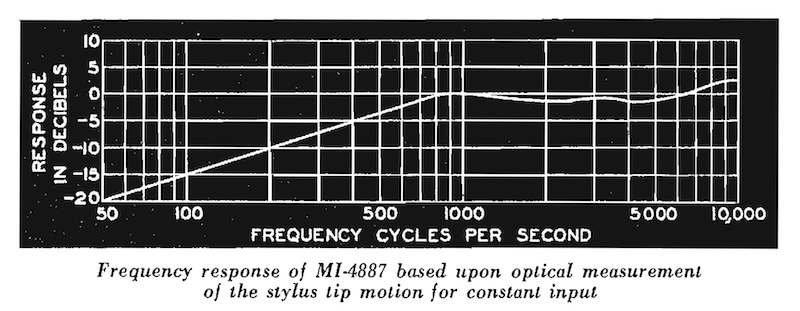
source: “RCA Broadcast Station Equipment, July 1939”, p.57.
RCA MI-4887 カッターヘッド自体の記録周波数特性グラフ
ターンオーバー周波数が800Hzあたりなのが興味深い
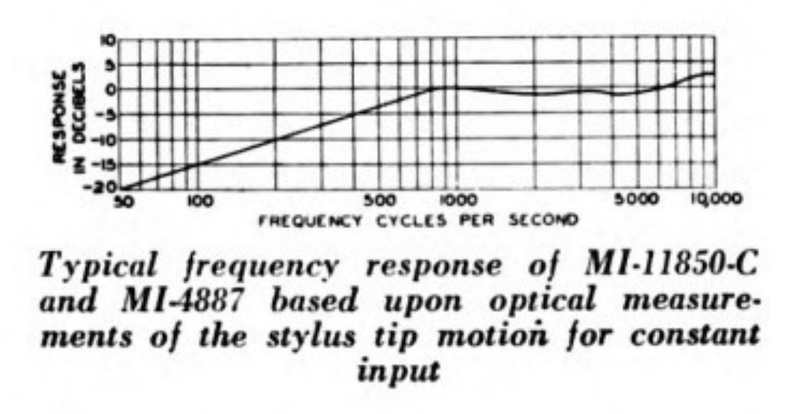
source: “RCA Broadcast Audio (Speech Input) Equipment, September 1945”, p.61.
RCA MI-11850-C カッターヘッド自体の記録周波数特性グラフ
これも800Hzターンオーバーなのが興味深い
これらのカッターヘッドにあわせて使用する録音用イコライザとして RCA MI-4916 Orthacoustic Recording Filter (1940) および MI-4916-A (1950) がラインアップされていました。カッターヘッド自体の特性を補正する目的で、この録音用イコライザが用意されており、両者の合計特性でちょうど RCA/NBC Orthacoustic 特性、つまり 1942年 NAB 録音特性「に近い」記録特性が得られるようになっています。
For use with these cutterheads, RCA also developed and added MI-4916 Orthacoustic Recording Filter (1940) as well as MI-4916-A to their equipment lineup. These filters were used to obtain an overall frequency response characteristic of MI-4887 and MI-11850-C suitable for making recordings with Orthacoustic (= 1942 NAB) frequency response, that was “6dB slope below 500Hz, constant velocity above 500Hz”.
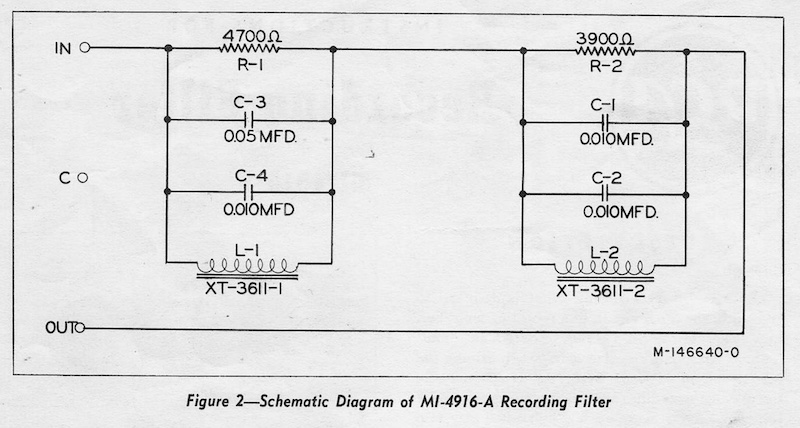
source: “Instructions for Recording Filter MI-4916-A”, p.2
1950年頃の取説に記載された、MI-4916-A 録音フィルタの回路図
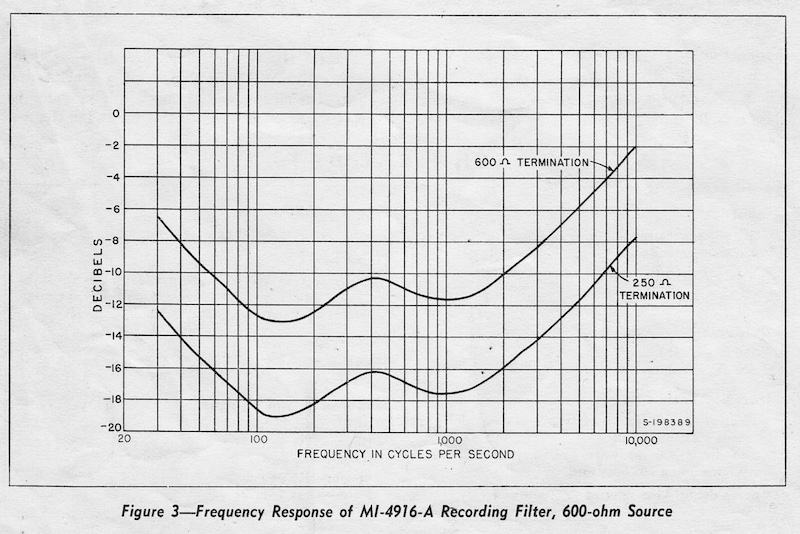
source: “Instructions for Recording Filter MI-4916-A”, p.2
1950年頃の取説に記載された、MI-4916-A 録音フィルタ自体の周波数特性グラフ
ちなみに、理想的な 1942 NAB 録音カーブと、MI-11850-C カッターヘッド + MI-4916-A 録音フィルタによる録音カーブの差分は、1950年のカタログに掲載されていました。規格に厳密なプロフェッショナル市場においても、このくらいの誤差は許容されていたわけですし、だからこその NAB 規格上で許容誤差 ±2dB と規定されていたことが読み取れます。
The difference between the “1942 NAB’s (ideal) recording curve” and the “actual curve obtained with MI-11850-C cutterhead + MI-4916 filter” can be seen on the RCA’s 1950 Catalog. Although professional studios were very strict in standards and regulations, such amount of tolerance was accepted – and that was why the NAB Standard noted as “tolerance: ±2dB”.
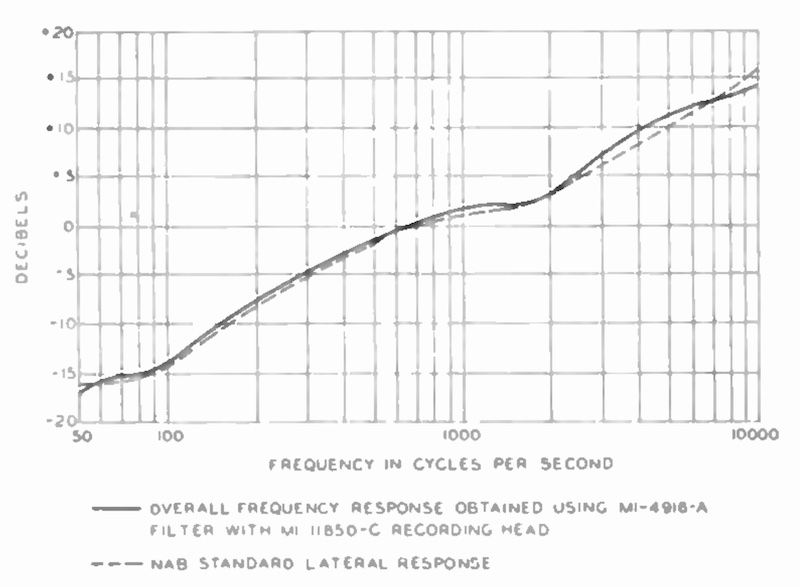
source: “RCA Broadcast Equipment Catalog (AM, FM and Television), 1950”, p.100.
MI-11850-C カッターヘッドの特性 + MI-4916-A 録音フィルタの特性の合計による、最終的な記録特性グラフ(実線)
NAB 録音カーブ(破線)との誤差が非常に興味深い
8.3.3 RCA Broadcast News, No.55, June 1949
RCA が放送業界向けに定期的に発行していた技術雑誌「RCA Broadcast News」の1949年6月号では、理想的なカッターヘッド記録特性(ターンオーバー周波数500Hz、それ以下が6dB/オクターブスロープ)と、MI-11850-C カッターヘッドの記録特性(ターンオーバー周波数約800Hz、それ以下が約5dB/オクターブスロープ)の差分を修正するための、クロスオーバフィルタの技術解説記事 “Crossover Filter For Disk Recording Heads” が掲載されています。
June 1949 issue of RCA’s technology-oriented magazine “RCA Broadcast News” contains the technical article “Crossover Filter For Disk Recording Heads”, that describes how to design the circuit to compensate the frequency response of MI-11850-C cutterhead (turnover frequency at 800Hz, 5dB/octave slope under 800Hz) to obtain the ideal cutterhead’s recording frequency response (turnover frequency at 500Hz, 6dB/octave slope under 500Hz).
この記事の場合は、MI-4916-A 録音フィルタを使う方法(カッターヘッドの記録特性の補正 + NAB カーブのプリエンファシスを一気に行う)ではなく、カッターヘッドの特性をフィルタによって理想的に揃える方法についてのみ解説しており、その上で 100Hz 以下の低域プリエンファシスと中高域の100μsスロープによる高域プリエンファシスを加えて、1942 NAB カーブを実現するように、といった流れになっています。
This article demonstrates, unlike using the MI-4916-A Recording Filter (that compensates the cutterhead’s recording frequency response, plus applying pre-emphasis for NAB curve at the same time), only compensates the cutterhead’s frequency response with the designed filter. After that, readers would prepare the circuits to accomplish bass pre-emphasis and treble 100μs pre-emphasis to meet the NAB recording curve.
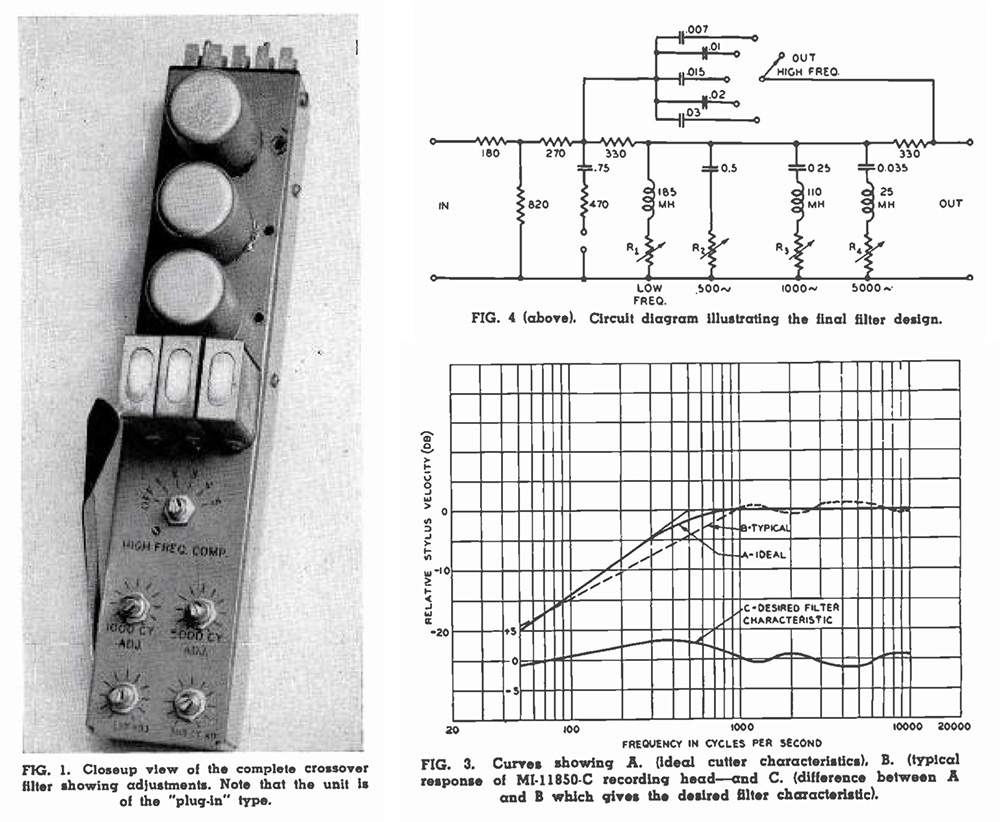
source: “Crossover Filter For Disk Recording Heads”, H.E. Roys, RCA Broadcast News, No.55, June 1949, pp.20-23
MI-11850-C カッターヘッドの記録特性を、ターンオーバー500Hzの理想的な記録特性に補正するためのフィルタ設計記事における図版群
図3のグラフCが、理想的記録特性との誤差で、これを実現するフィルタを図4の回路図で実現
The NAB standard curve, Fig.2, includes high-frequency tip-up having the characteristic shape of a resistance and cpacitance network of such proportions that the time constant T = RC is equal to 100 microseconds (R expressed in ohms; C, in farads). Some additional low-frequency boost, below 100 cycles, is also included, as illustrated by the flatness of the curve between 100 and 50 cycles. If we subtract the 100-microsecond tip-up curve from the standard and extend the low-frequency response on a 6 db. per octave slope, we then have the characteristic of the ideal cutter.
NAB標準録音カーブには、高域に盛り上がるようなカーブがあり、これは時定数 T = RC が 100μs (R はオーム、C はファラド)となるRC回路における特性である。さらに 100Hz 以下の低域ブーストも含まれており、NAB標準録音カーブにおける 100Hz の平坦なエリアに現れている。もし、この 100μs の盛り上がり(プリエンファシス)を取り除き、低域の 6dB/オクターブスロープを延長すれば、それが理想的なカッターヘッドの周波数特性となる。
Crossover Filter For Disk Recording Heads”, H.E. Roys, RCA Broadcast News, No.55, June 1949, pp.20-238.3.4 Catalog of Western Electric’s 1945 Reproducing Equipment / 1945年 WE 再生機器カタログ
最後に、再生機器側についても1例だけみてみましょう。ここでは1945年 Western Electric 製 5A トーンアーム + 9A ピックアップ + 171A リピーティングコイル(トランス)+ KS10066 スイッチアセンブリのカタログから引用します。171A トランスが使われているので、KS10066 のスイッチ内にある回路と合わせて、この再生用フォノイコは LRC 型または LR 型であることがわかります。
Lastly, let’s take a look at one example of the reproducing equipment. Below is quoted form the catalog of Western Electric’s 5A tonearm, 9A pickup, 171A Repeating Coil (transformer), and KS10066 Switch Assembly. So this setup, if we see it as a playback EQ, is either LRC or LR.
再生特性をロータリースイッチで切り替え可能になっているわけですが、下の特性グラフにおいて、V1 が 1942 NAB 標準規格の縦振動盤用の再生カーブ、L2 が 1942 NAB 横振動盤用の再生カーブ、その他の L1, L3, L4, L5 および V2 は、V1 (つまり縦振動用)のカーブを基本としつつ、高域のスクラッチフィルタ(サーフェスノイズ軽減用)の適用量が異なるものとなっています。
Reproducing characteristic is switchable with the KS10066 rotary switch. On the frequency response curves as shown below, V1 is the reproducing curve for 1942 NAB Standards for vertical-cut records; L2 is the NAB curve for lateral-cut records; other plots – L1, L3, L4, L5 and V2 – are basically the same as V1 (1942 NAB vertical), except the amount of “scratch filter” (to reduce surface noise) is different.
実際に L3 や L4 の再生特性とぴったり合致する録音特性で制作された盤があったわけではなく、あくまで盤の状態にあわせて高域減衰量を調整するための措置です。V2 の説明文にも「V1と同じだが、古い縦振動盤や摩耗した縦振動盤を再生する際の再生品質のため、スクラッチフィルタが追加されたものである」と書かれています。
These “irregular” settings were used for the playback of very old shellac records or heavily worn-out discs. Please note that there was not a record that was cut intended to be reproduced with such curves as L4 or L5 for the best results. Actually, the notes below the graph reads: “V2 is the same except that scratch filtering is added to improve reproduction of old or worn records”.
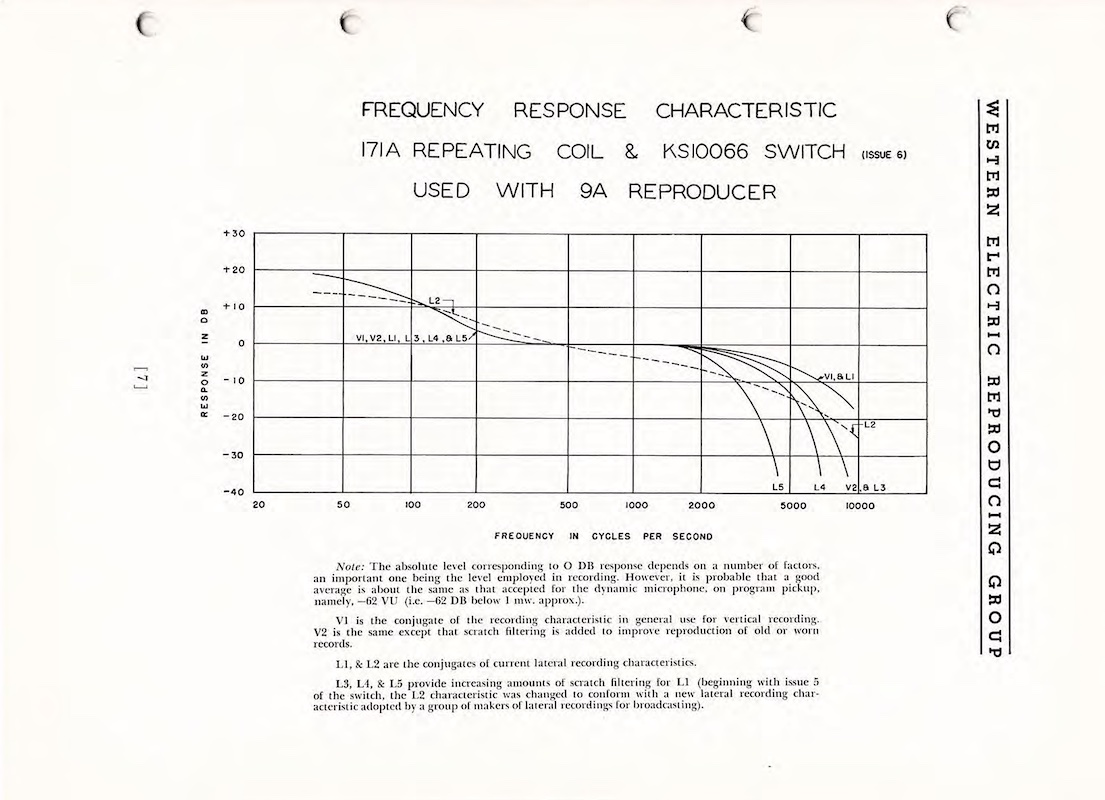
source: “Western Electric Reproducing Group For Radio Broadcasting and for Sound Distribution Systems”, Western Electric, 1945, p.7
171A リピーティングコイル + KS10066 スイッチで切り替え可能な、9A ピックアップでの再生周波数特性
L2 が 1942 NAB 横振動盤再生カーブ、その他は縦振動トランスクリプションや古い78回転盤用の再生カーブ(ノイズフィルタの適用範囲が異なる)
L5 は5,000Hz 以上がカットされており、アコースティック録音盤や状態の悪い78回転盤再生用と思われる
L2 is for lateral-cut transcription with 1942 NAB curve; others are for vertical transcriptions as well as old 78rpms
the amount and area of scratch filters are different; for example, L5 position cuts entirely above 5,000Hz – probably aimed for old acoustically recorded 78rpms as well as worn-out 78rpms
8.3.5 1948 Western Electric Catalog / 1948年 WE カタログ
もう1つだけ。1948年 Western Electric カタログでは、171A リピーティングコイル(トランス)はそのままですが、イコライザ + スイッチアセンブリが KS-13386 に変更になっており、選択可能なカーブが微妙に変更されています。具体的には、1945年の KS-10066 に比べて、横振動用のカーブのバリエーションが増やされ、1942 NAB 再生カーブに準じつつ、3種類のロールオフ値が選択可能になっています。KS-13386 の内部写真を見ると抵抗とコンデンサが積まれているので、全体として LRC フォノイコということになります。
Yet another example here – in 1948 Western Electric Catalog, 171A Repeating Coil (transformer) is still there, but the KS-10066 Switch Assembly is replaced with KS-13386 Equalizer & Switch Assembly, and a different reproducing curves are provided. More precisely, there are three different reproducing curves (all basically the same as 1942 NAB Curve) for lateral transcription, except two of them have different roll-off parameters. Judging from the internal picture of KS-13386, we see resistors and capacitors inside, so overall this setup is LRC EQ.
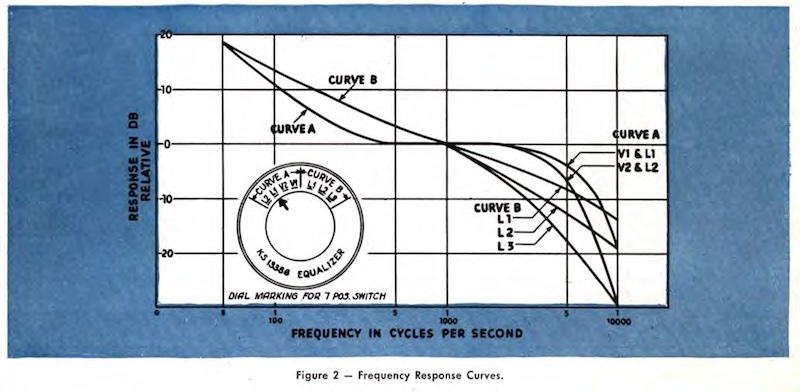
source: “1948 Western Electric Catalog”, Western Electric, 1948, p.8
171A リピーティングコイル + KS13386 イコライザ/スイッチで切り替え可能な、9A/9B ピックアップでの再生周波数特性
Curve B が横振動NAB再生用で、L1, L2, L3 でロールオフの度合いを変更可能(ただし、どれも -16dB at 10,000Hz になっていないことに注意)
Frequency Response Curves of 171A Repeating Coil + KS13386 Equalizer/Switch + 9A/9B Reproducer.
Three curves of Curve B are for lateral NAB discs, with different roll-off values (please note that none of these three curves have the roll-off of -16dB at 10,000Hz, which is the best for 1942 NAB Recording Standards).
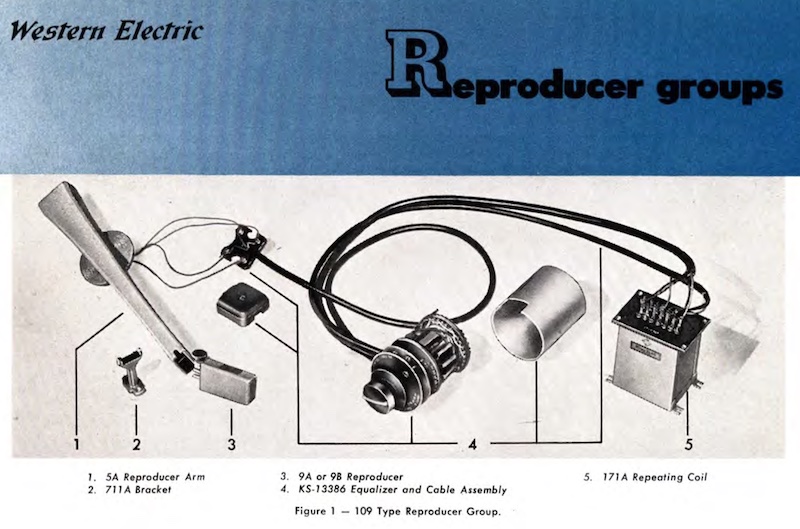
source: “1948 Western Electric Catalog”, Western Electric, 1948, p.8
8.4 Some of my personal thoughts so far / ここまで学んできて個人的に思うことなど
長編となってしまった本稿 Pt.8 もまもなく終わりです。RIAAの話に到達するには未だ道半ばですが、1920年代の世界初の電気録音から始まり、最初のマイルストーンである1942年NABカーブまで、やっと到達しました。
Well, the very lengthy Part 8 of my long article is coming to an end. Although I am still half way down the road to the RIAA Standardization, I am finally here – starting from the first electrical recordings in the 1920s, and reaching here at the topic of 1942 NAB Standard, that should be the first milestone of my entire study and research.
2022年7月中旬に、ふと思い立って、ディスク録音の歴史について深く調べ学び直そうと思ってから、はや5ヶ月近くたちました。この間に読みまくり調べまくった当時の技術文書や論文、雑誌などは数百点以上にのぼるでしょうか。そして、自分もびっくりするくらい、技術や歴史、経緯について、大量の新しい学びを得られました。
Nearly five months have passed since I somehow started to study, investigate and research the history of disc recording in July 2022. I have read so many technical documentations, technical papers, magazine articles, etc. – prorably a few hundreds of them. Furthermore, as I am surprised myself, I have learned an incredible amount of technology, history and its background.
こうやって過去の歴史資料を学べば学ぶほど、次のような思いは増すばかりです。
The more I have learned from the historical resources and documents from the past, the more I feel something as follows:
たとえ規格が厳密に決められていて、それに準拠しようとしていたとしても、実際に記録された際の録音カーブは結局、どのような回路を使って実現し、どのような設定がされたかによって記録特性には微妙な誤差が生じることになります。後年のように、フィードバックカッターがフラット記録できる前提で、全帯域のイコライジングカーブを回路で実現している場合もあれば、1940年代当時のように、カッターヘッドをまずターンオーバー500Hzの特性にフィルタで微調整してから、そののちNAB用プリエンファシスを別の補正回路で設定する場合もあります。中には、極端な例ではありますが、あまり深刻に考えず、補正もきちんとしないまま録音してしまったエンジニアもきっといたことでしょう。
Although the standards were strictly defined, and although an engineer tried to conform to the standards, the final recording frequency characteristic would depend on what electrical circuit he/she used, what parameter(s) he/she applied to the circuit – resulting in a minor error in strict accuracy. In later years – from around 1950 – “feedback cutterhead” that could cut flat response became popular, and all the recording equalization and pre-emphasis was done by a dedicated equalizer. On the other hand, older technologies like in the 1940s, cutterhead’s frequency was initially fine-tuned for complying with “turnover frequency at 500Hz, constant amplitude below that, constant velocity above that”, then bass/treble preemphasis were applied to conform to the NAB recording characteristic. Also, there could be such engineers – although there were few and it would be an extreme example – who didn’t seriously take the calibration and compensation into account, and did recordings “as it was”.
社内で厳格にルールを定め計測・補正し、記録がしっかり残っている大手レーベルや録音スタジオを除き、「〇〇レーベルの19XX年録音だから、△△カーブのはず、よってターンオーバーの値はこれ、ロールオフの値はこれ」という単純な話には到底なりそうにない、そう思う所以です。結局は、ある特定の録音の際にエンジニアがどのようなパラメータの回路を使って録音補正していたか、がわからない限り、たとえカーブ可変フォノイコを使ったとしても、100%正確な再生補正は不可能である、ということです。
Widespread statements like “this particular record is of Label AA, recorded in 19XX, so it should be correctly reproduced with the Curve BB – so the turnover value should be CC, and the rolloff value should be DD” won’t always reflect the truth, except major labels or famous recording studios where the calibrations and the compensations were made in order to comply very strictly with in-house rules, and such documentation survives. After all, 100%-perfect reproducing compensation for a particular recording – even utilizing variable EQ phono preamps – won’t be possible, without knowing the exact parameters and the exact circuits that the recording engineer-in-charge actually used.
そもそも近年の「ターンオーバー」「ロールオフ」によるカーブ可変フォノイコライザは、RC回路による録音・再生補正を前提としています。しかし、今までみてきたように、当時の録音補正は、LRC回路で行われていたり、LR回路で補正されていたり、RC回路による実装が提案されていたり、それぞれ微妙に特性が異なっていました。だからこその「±2dB許容誤差」というわけです。
What’s more, variable EQ “archival” phono preamplifiers that can adjust “turnover frequency” and “roll-off value” preassumes the recording/reproducing compensation with the RC circuits. However, as we have seen from Part 1 to Part 8 of my entire article, LRC circuits were used in some recording studios, while LR circuits were used for compensation, and some papers recommends RC circuits for playback compensation – all of these have slightly different characteristic in nature. This is also why the NAB Standards stated “±2dB of tolerance”.
RC回路によるカーブ可変フォノイコであっても、その実現方法はいろいろあります。ちょうど先日、Nicholas Bergh さんと高域プリエンファシス実現回路に関する記事の話をしていた際、彼もこの辺りの話を聞かせてくれました。
Also there are a few possible circuit designs to design variable EQ phono preamplifiers with RC circuit. A few days back, when Nicholas Bergh-san and I were exchanging emails about the treble pre-emphasis curve and the possible circuits, he kindly taught me the followings:
There are multiple ways to accomplish the 75 or 100 microsecond eq (treble preemphasis/deemphasis). It can be accomplished with a variety of different RC values or via LRC or just LR. However, I think the only way to accomplish it with RC is to do it actively inside an amplifier. To do passive external EQ, which was still the standard in the US then, only LR or LRC is possible. This type of EQ works by essentially mis-matching the impedance of the input transformer.
75μsや100μsのイコライザ(高域プリエンファシス/デエンファシス)の実現には複数の方法がある。異なる値のRC回路でも実現可能だし、LRC回路でも可能、またはLR回路だけでも可能だ。だが、RC回路で実現するには、アンプ内部でアクティブイコライザとして実装する必要があると自分は考えている。当時の米国において標準的であった、外付けのパッシブイコライザの場合は、当時は LR回路または LRC回路による実現しかありえない。このタイプのイコライザは、基本的には入力トランスのインピーダンスをミスマッチさせることで機能を発揮させる仕組みだ。
Between the graph you sent and the one I sent, you can see the difference in pre-emphasis between 75 and 100 microseconds. It is interesting when looking at the circuits of typical archival phonograph pre-amps that offer multiple curves. Inside there will typically be rows of resistors and capacitors for the different curves, but it is an option to either change the resistor value or the capacitor value. Some companies choose changing the resistor values and some change the capacitor values.
送ってもらったグラフと、私が送ったグラフでは、75μsと100μsの両者でプリエンファシスが異なることが見てとれるだろう。複数のEQカーブに対応可能なフォノイコライザの回路を調べると非常に興味深いことが分かる。それらカーブ可変フォノイコの内部では、カーブごとに抵抗とコンデンサがずらっと並んでいるのが普通だが、その際、カーブごとに抵抗値を変更するのか、コンデンサ容量を変更するのかは、設計者によりまちまちだ。コンデンサ容量固定のまま抵抗値を変えることで各種カーブに対応させる回路設計を選択する会社もあれば、抵抗値固定のままコンデンサ容量を変更することで各種カーブに対応させる回路設計を選択する会社もある。
quoted from the email written by Nicholas Bergh to me on Dec. 1, 2022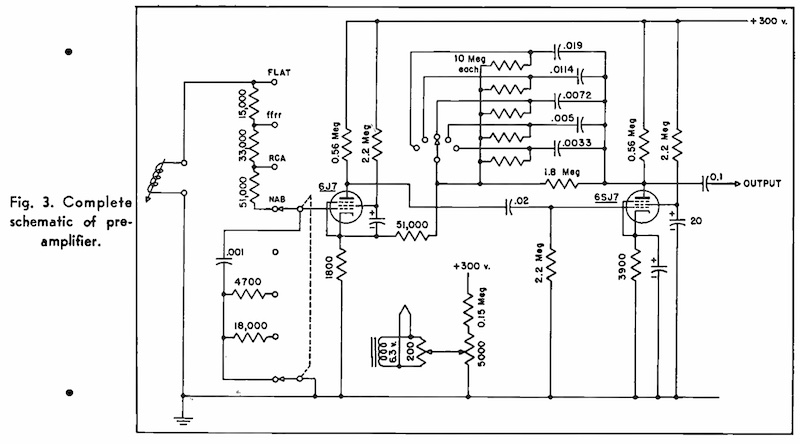
source: “Versatile Phonograph Preamplifier”, Paul W.St. George & Benjamin B. Drisko, Audio Engineering, March 1949, Vol.33, No.3, pp.14-16, 40-41.
Audio Engineering 誌1949年3月号に掲載された、カーブ可変フォノイコ回路設計記事より。
この記事上では、抵抗値は固定(10MΩ)、コンデンサ容量を可変とすることで、各種カーブに対応する設計となっている。
From an article of designing a variable EQ phono preamplifier. In this schematic, register values for all curves are fixed (10 megaohms), while the capaciter values are different among them
そして(ごく一部の著名な録音を除き)多くのレコードについては、どんなパラメータの録音機材で収録されたかの探求は不可能に近いから、結果として我々リスナーは、一般論的な傾向や研究資料を通して、そして手持ちの可変カーブフォノイコを使ったり自作するなどして「だいだい」「いい感じの」再生カーブに落とし込んで、個々人が満足するしかない。さらにそれが正解である保証はなかなか得られない、と。
Also, as a consequence, we cannot know (and it is nearly impossible to know) the exact equipment, exact parameters, and exact circuits the engineer used for a particular recording session – except a handful of famous recording sessions. After all, we the listeners have to be satisfied with selecting “approximately” “so-so” reproducing curve, by making reference to well-known general rules as well as research documentations, utilizing variable EQ phono preamps we have (or DIY-ing such preamps). Furthermore, you can’t promise the logical/evidential correctness of the curve you finally chose.
ここ数ヶ月に渡って大量の資料や論文を読み込んできましたが、調べれば調べるほど、「ある特定の録音の特定のプレスにおける正しい再生カーブは何か」という問いは、少なくともLP登場以前の盤については、泥沼のように深いテーマで非常に困難なチャレンジであると感じます。
I have dived into the vast amount of technical documentations and papers for many months. But the more I do studies and researches, the more I feel that the question “what is the correct reproducing curve for a specific recording on a specific pressing?” would become profound and deep, and solving the question would become a more difficult challenge – especially for discs recorded and pressed in the pre-LP years.
そして、そのような困難なチャレンジと深淵なる探求を(過去のレコード録音のみならず、戦前トーキー映画の録音や戦後ハリウッドにおける録音においても)当時の機材現物を入手し、部外秘の資料を入手し読み解き、実際に使用するなどして特性を理解したりすることを通じて、職業として研究を行っている、そんなプロフェッショナルの1人が、かの Nicholas Bergh さんである、ということです。心より尊敬します。
The last thing I note here is that, Mr. Nicholas Bergh is one of such persons who never hesitate to demonstrate his enormous passion for the truth. He is a true professional researcher and a true professional engineer, who precipitately have dived into such profound quest for the truth – not only of historical disc recordings, but also of the recordings of historical talking motion pictures, and of historical magnetic sound recording masters in Hollywood – by really obtaining vintage/historical equipments, by looking for “priviledged” documentation, by doing a through study of them, and by really restoring/operating such historical equipments. I really respect him (and his effort and output) from the bottom of my heart.
わたし自身を含め、世界中の多くのオーディオマニアやレコードコレクターが、録音再生カーブについて「軽々しく」語るのは、あまりにもおこがましい、そのように感じています。「あまりに単純化された事実やまとめ」は、深淵な世界かつ複雑な歩みを経た歴史の真実を何も語ってくれないのです。
Many audiophiles and record collectors from all around the world – probably including myself – should not be impudent enough to talk about recording/reproducing curves, especially “too lightly” without any deciated research and study. I really do think so. “Too simplified facts and summary” never tells the truth of the deep world and the complicated history.
今後、マイクログルーヴ時代に突入することになるわけですが、ますます多くの資料や論文に出会い、ますます多くを学べること、これから楽しみです。
My coming articles will eventually go into the “long playing microgroove” years – I’m already excited that I am going to find many more documentations and papers, and to study so many things from them in the near future.
8.5 The summary of what I got this time / 自分なりのまとめ
今回は自分史上最長の記事となってしまいましたが、分割せずに一挙に掲載することとしました。
This Part 8 became the longest web article I have ever written.
今回は、1942年に策定されたNAB録音・再生標準規格のエピソード、およびそのカーブを実現するための回路や機器の話を長々と調べてきました。
Thsi time in Part 8, I have spent very long time investigating the whole story and background toward the formulation of the 1942 NAB Recording and Reproducing Standards. I also studied about several examples of the electrical circuits to accomplish the NAB curve, as well as the equipments at that time.
さてさて、今回の内容をざっくりまとめると、こんな感じでしょうか。
…so, the rough summary of my understanding in this article would be something like this:
1939年暮れに RCA/NBC が Orthacoustic カーブを発表した2年後、全米のラジオ協会である NAB (National Association of Broadcasters) が中心となり、トランスクリプション盤の録音・再生標準化作業が開始された。1941年5月に開始され、太平洋戦争突入の時期も超えて、1942年5月に正式決定されることとなった。
Two years after RCA/NBC introduced Orthacoustic curve for electrical transcriptions in late 1939, NAB (National Association of Broadcasters) started the work of the recording/reproducing standardization for electrical transcriptions. The work started in May 1941, held so many meetings through the outbreak of Asia-Pasific War, and the Standards were officially adopted in May 1942.
1942年NAB録音・再生標準規格は、暫定的に16項目から構成されており、その中には Bell Labs/WE 由来の縦振動トランスクリプションの録音再生特性と、RCA/NBC Orthacousitc 由来の横振動トランスクリプションの録音再生特性がそのまま標準規格として採用されている。16項目の標準規格決定には多くの議論が伴ったが、全体として非常に民主的平和的に進行した。
The 1942 NAB Recording and Reproducing Standards consists of sixteen items of “standards” and “good engineering practice”. It includes recording frequency response for vertical transcription discs, originated from the Bell Labs/WE curve, as well as that for lateral transcription discs, originated from the RCA/NBC “Orthacoustic” curve. Some controversy occured toward the formulation of sixteen items, but overall the process went very peacefully and democratically.
NAB 規格に合わせて各スタジオのイコライザ修正が行われたが、当時は録音イコライザを実現する回路設計も多種多様で、真の意味で完璧に統一されていたわけではなかった。そのような事情のため、NAB 規格上でも許容誤差が±2dBと若干ゆるめに設定されていた。
Each studio started modifications of the existing equipment to follow the NAB Recording Characteristic. However, there was many variations of equalizer circuits and not unified. To cope with such variability, “tolerance ±2dB” was mentioned in the Standards.
1941年12月の太平洋戦争、および第二次世界大戦勃発により、NAB 標準規格策定作業は延期となり、続く作業は戦後に再開することとなる。
The outbreak of Asia-Pacific War, as well as WWII, NAB Standards Committee’s work was postponed until the end of the war.
次回は戦中〜戦後のいろんな事情について書く予定です(詳細は未定)。
My next post will feature the continuing history, including various topics during the WWII and the post-WWII (details to be determined).
» 続き / Sequel: “Things I learned on Phono EQ curves, Pt.9” »
